Our main focus is the reforestation with a goal to help rehabilitate more than 500ha of damaged forests in the Lurë-Dejës Mt. National Park. We employ the local community to execute our operations which creates a strong relationship towards our projects and allows us to contribute substantially to the local economy. This approach is a main difference from other organizations and creates long-lasting results, read more.
KEY FACTS
| Year | Trees planted | Area restored | Survival rate | Price per tree | CO2 offsetting |
|---|---|---|---|---|---|
| 2021 | 2,712 | 2.2 ha | 78% / N/A / 88.25% | €2.04 | 68kg |
| 2022 | 10,000 | 7.02 ha | 84.65% / 78.48% | €2.13 | 319kg |
| 2023 | 10,081 | 6.38 ha | 56.40% | €1.91 | 570kg |
| 2024 | 11,470 | 13.84 ha | |||
| 34,263 | 29.44 ha | 74.38% | €2.03 | 957kg |
For detailed information about our survival rate monitoring methodology please refer to the How are we monitoring? section.
QUICK LINKS
Reforestation timeline
2024
11,470 / 13.84haIn terms of reforestation, 2024 was very successful and with quite a few important milestones. We planted 11,470 trees in 13.84ha, completing the restoration of 3 areas. We expanded activities to municipality land with NFA and supported other NGOs who wished to plant trees in the national park for the first time, among many more.
Completing the restoration of 3 areas
In 2021, we started working on restoring the first damaged area in the Lurë-Dejës Mt. National Park, and over the last 4 years, we obtained permission to restore three neighbouring zones with a total area of 63.5 ha. These areas were heavily damaged by the forest fires, and around 50% was suitable for reforestation. This year, we completed the restoration work for these areas.
We planted 9,770 saplings of Black pine (the majority from our tree nursery), completing the area we worked in 2022 and the remaining areas from the 2023 planting season. From now on, our work in these areas will consist of monitoring the survival rate, replacement of dead trees and maintenance of the planted trees, which will continue for the next 3 years.
This progress is a massive milestone for the project as we are now in the phase when the restored areas wait for the results of the monitoring period, after which they will be considered successfully restored (given that a sufficient survival rate is achieved). At that point we can apply for the change of status of the land from deforested to reforested.
Municipality land and cooperation with NFA
Throughout 2024, we worked on building a relationship with National Forestry Agency (NFA). The NFA is responsible for more than 70% of the forested land in Albania and is the primary authority for forest management.
This effort resulted in our first planting project on the municipality land close to Pregjë-Lurë, right at the border of the Lurë-Dejës Mt. National Park. We planted 1,700 Black pine saplings (from our tree nursery) in an area of 2.46ha. During the planting, we had the pleasure of hosting the general director and representatives of the NFA, representatives of the municipality of Peshkopi and the district of Dibër.
Cooperation with the National Forestry Agency is crucial as it opens the door for future planting operations on the municipality's land and other areas the agency manages.
8,000 saplings from the nursery
Another milestone was planting the saplings we produced in the Fushë-Lurë tree nursery, which managed to produce 70% of total number of saplings needed for this year. The saplings from the nursery have a better chance of survival as they are grown from the seeds collected in the area and are acclimatized to the local climate.
Our growing process differs from commercial nurseries, resulting in good quality saplings, much less plastic waste, lower transport costs, up to 70% reduction. We have more information about our saplings on the tree nursery project page.
We conducted monitoring tasks of the 2023 planting areas, which included small areas where we planted the saplings from the nursery. The survival rate of the nursery saplings was 88%, which is a fantastic result. However, the sample is too small to draw conclusions. Next year, during the monitoring of 2024 zones, we will better understand the survival rate of saplings from our nursery versus commercially available saplings.
Deepening community involvement
We continued to deepen our relationship with the local community, and this year, we had 40 workers participating in the planting operation, the highest number so far.
Very positive change came with involvement of more women during the planting phase. We are happy more and more women are able to work with us and have independent income. In 2025 we expect higher number of local women being employed during the spring season, working in the nursery as well as on replacing dead trees, in the reforested areas.
The project is also reaching out from the closest villages of Fushë-Lurë, Borie-Lurë and Gur-Lurë to the surrounding villages. This year we were able to welcome workers from the village of Vlashaj, almost 15km away from the planting area.
School events and CSO engagement
For the second autumn planting season we hosted school events. The 1st event was organized with the local school Sh.M.B. “Nikoll Kaçorri” in Fushë-Lurë and the other with the Nënë Tereza school from Rrëshen.
Like last year, we prepared a one day program for each school. The program consists of visit to the tree nursery, where the students have the opportunity to learn about different species, the processes of collecting seeds and growing the saplings. After the tree nursery we continue with visit to the planting areas and planting the saplings.
A significant achievement of the project was the cooperation with other CSOs that wanted to plant trees in the national park. We were able to support Albanian Ornithological Society and Terre des hommes, enabling them to organize their own planting events.
These two organizations financed a total 1,336 saplings within the 2024 planting areas where Trees for Lurë holds the planting permits. Albanian Ornithological Society financed and planted 336 during a the 1st weekend of November and Terre des hommes financed planting 800 saplings with local workers and planted the remaining 200 with schools from Elbasan, Fier, Peshkopi and Lurë during their event on 19th November 2024.
We delivered the 2–year old Black pine (Pinus nigra) saplings from our tree nursery, prepared the planting area with local workers, planted the saplings and provided the know-how for their tree planting events. We include these areas in our monitoring activities to provide survival rate information for the whole 2024 reforested area. The monitoring is conducted for next 3 consecutive years.
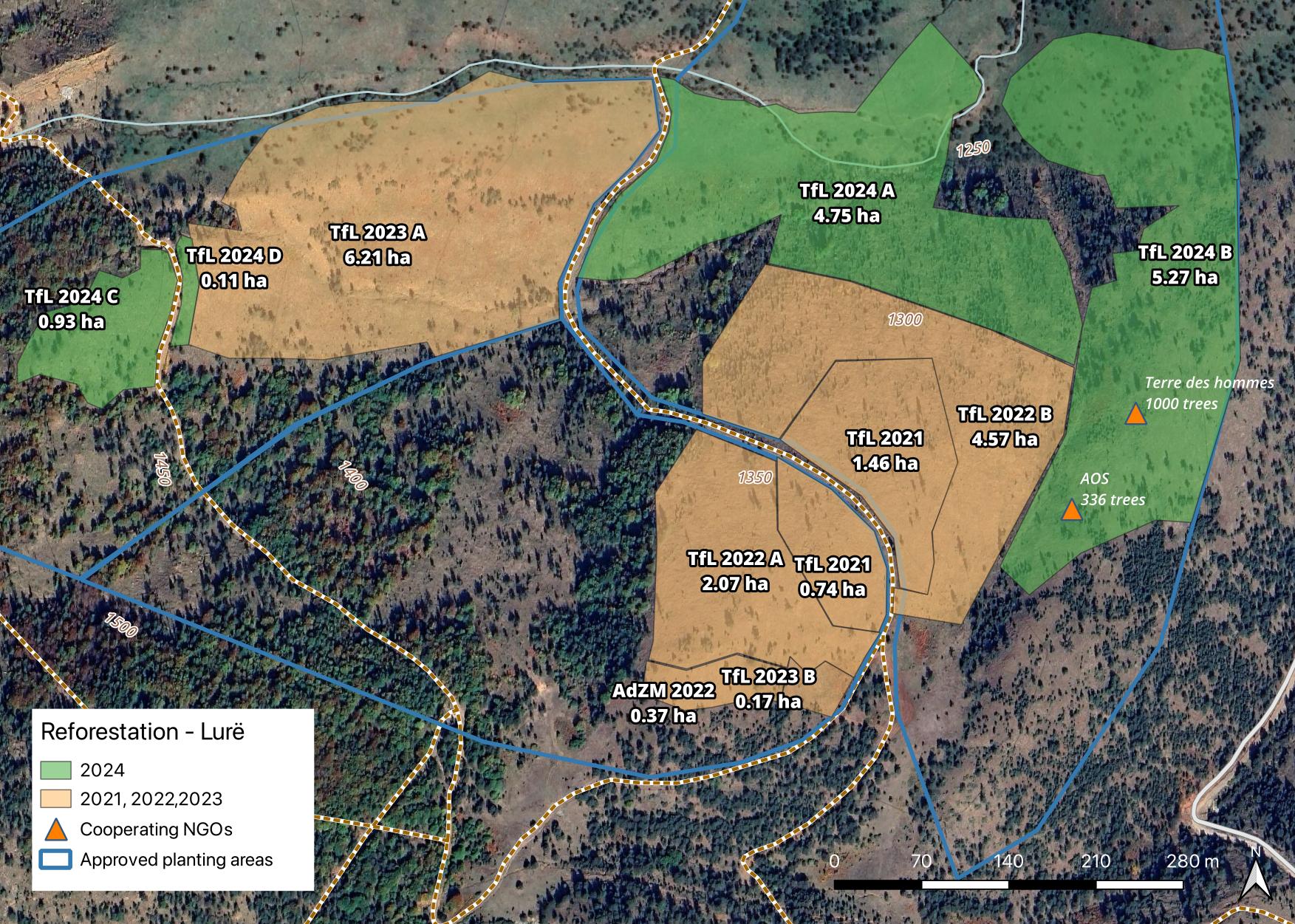
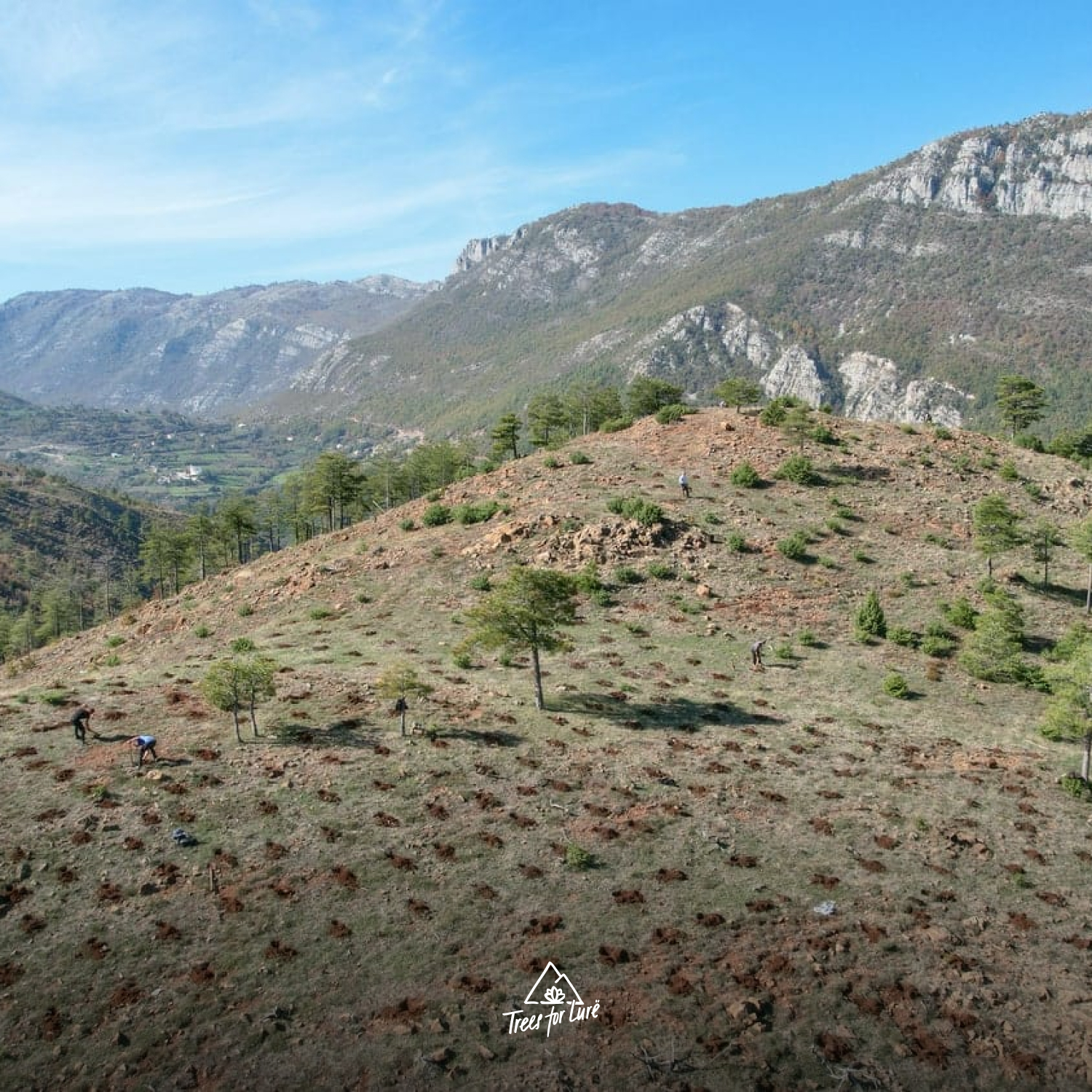
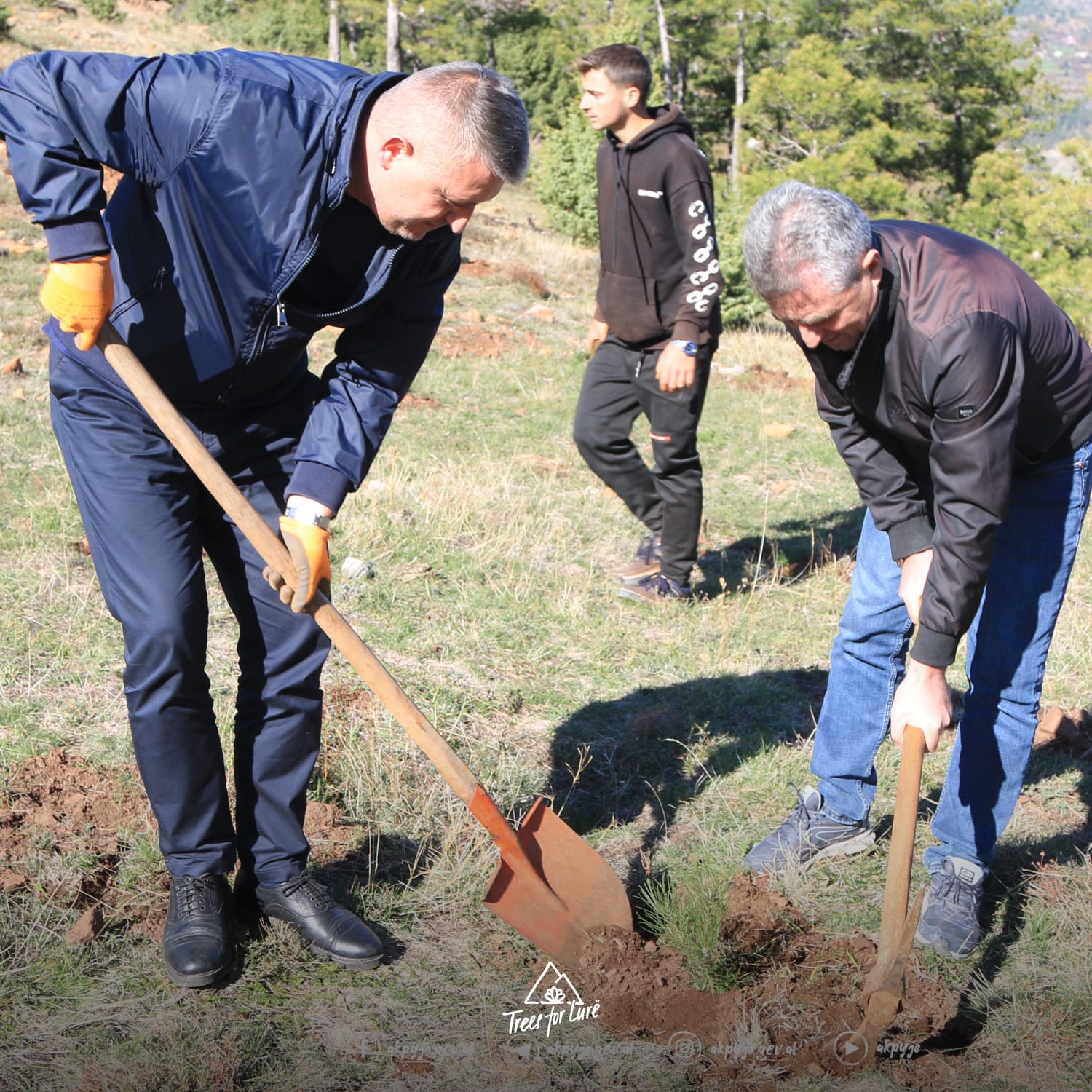
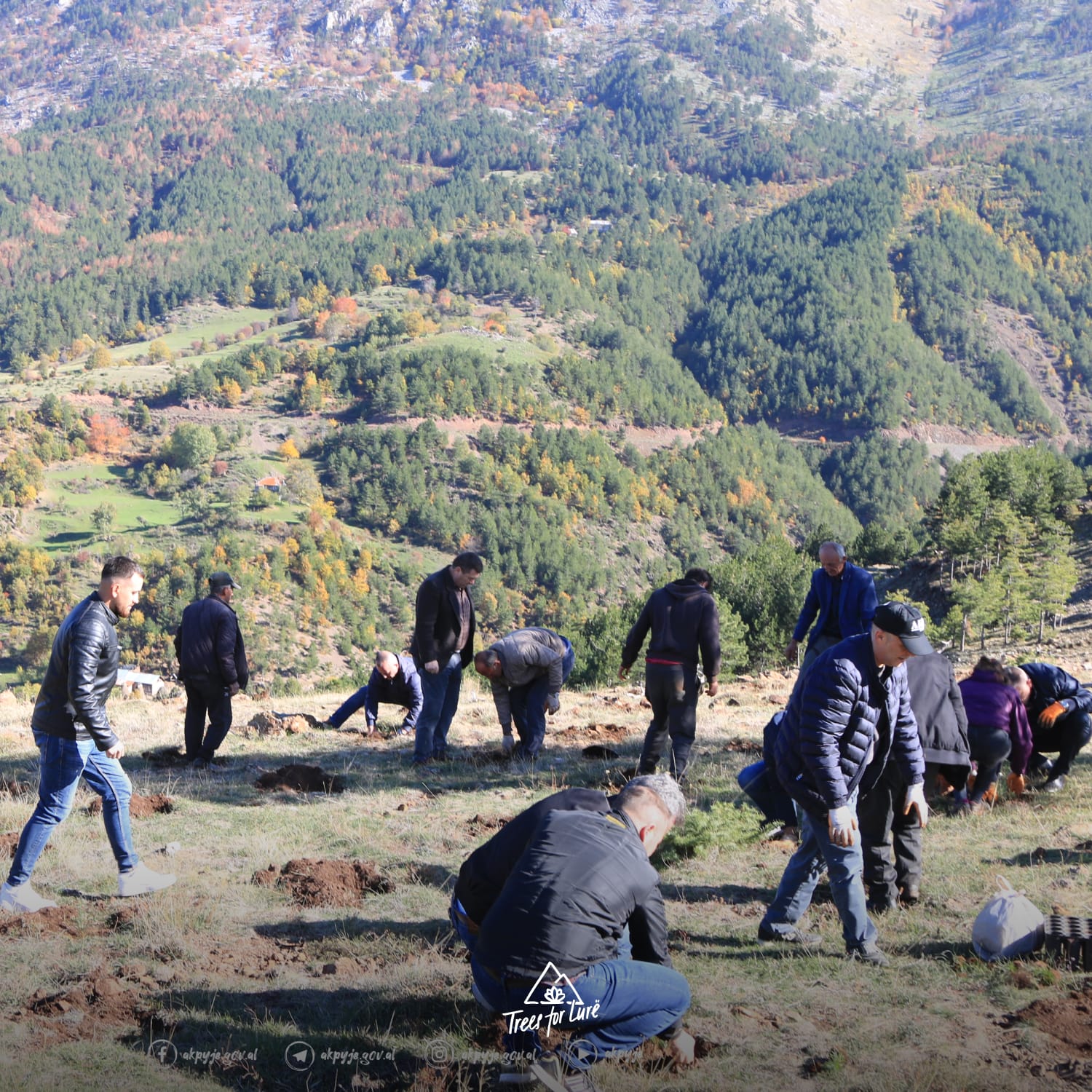
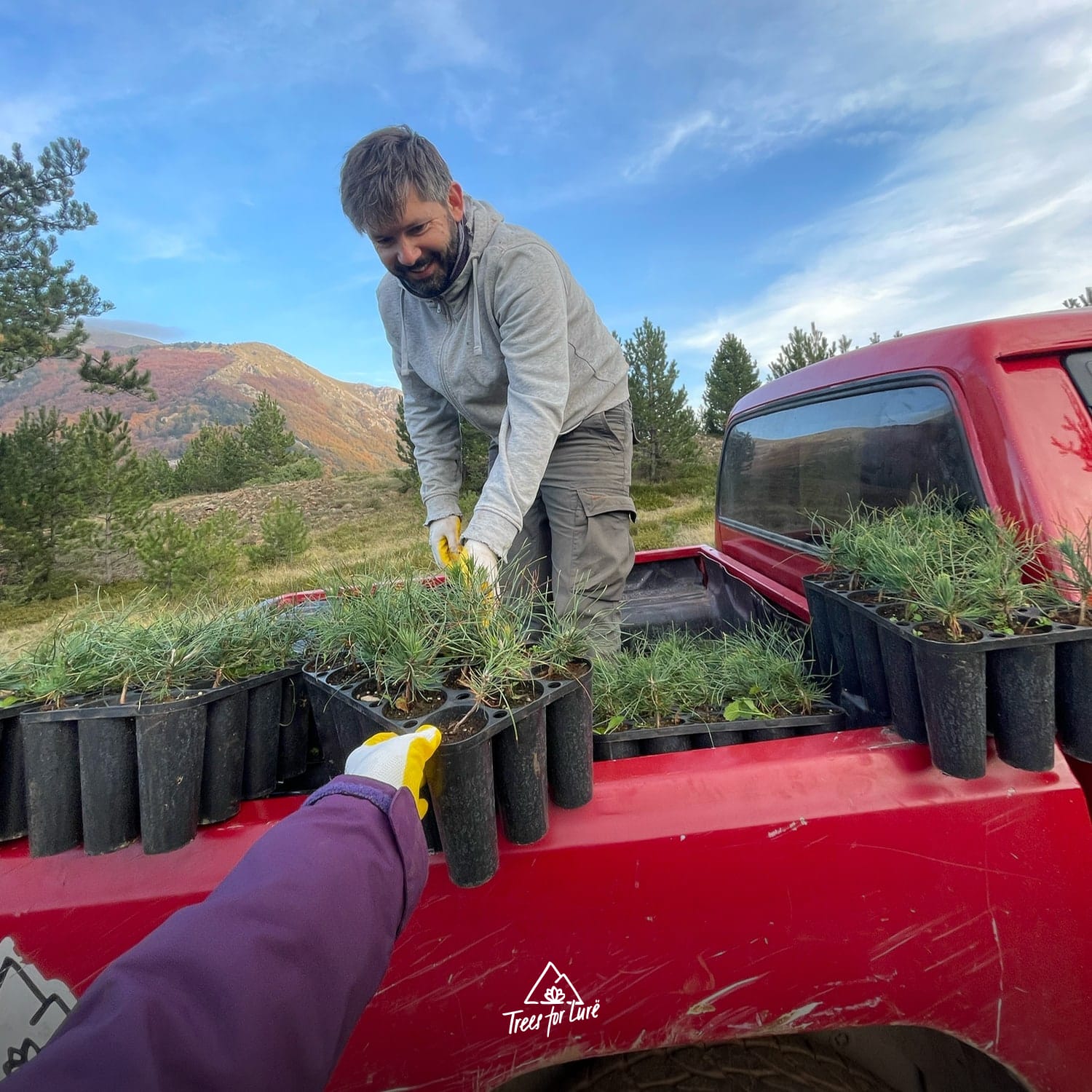
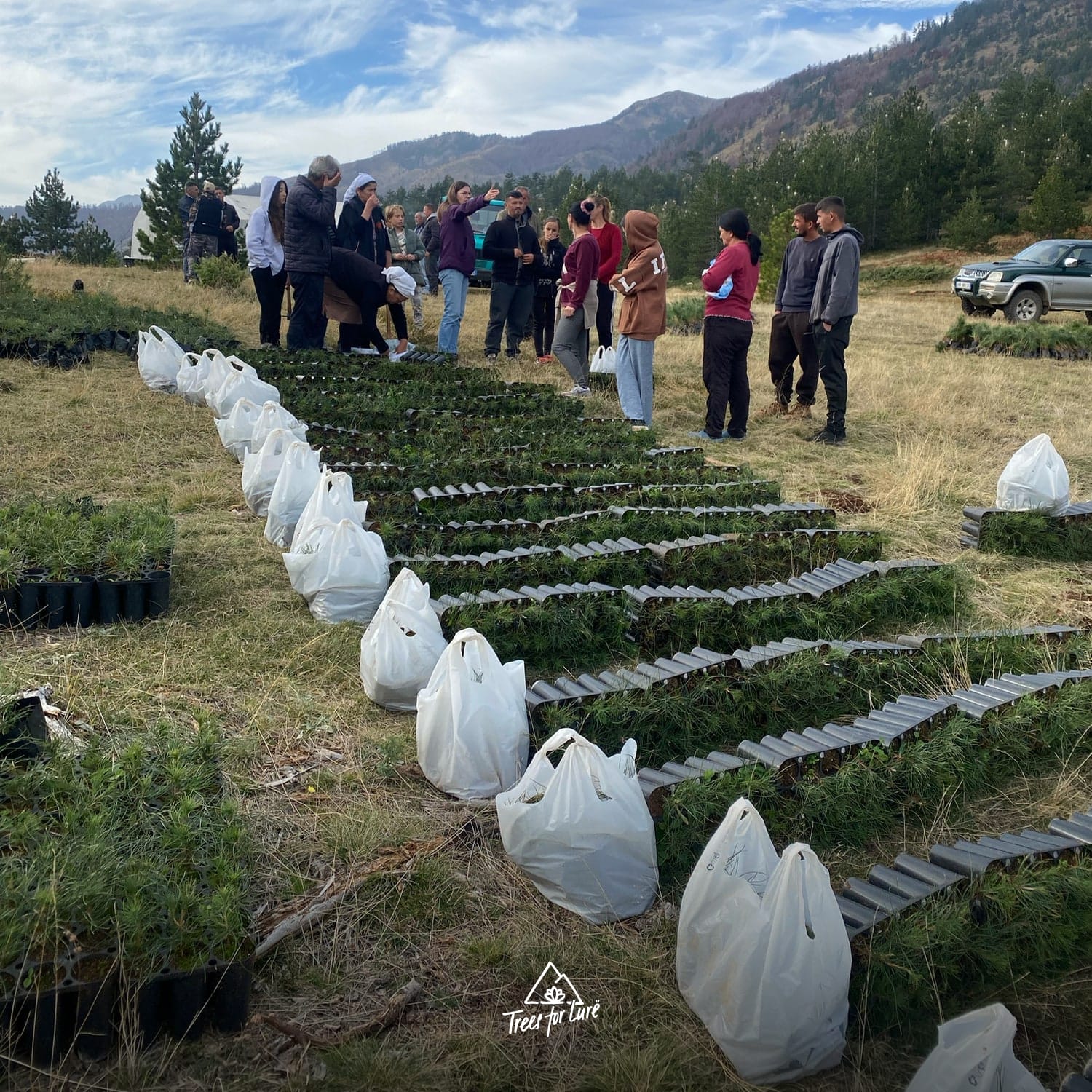
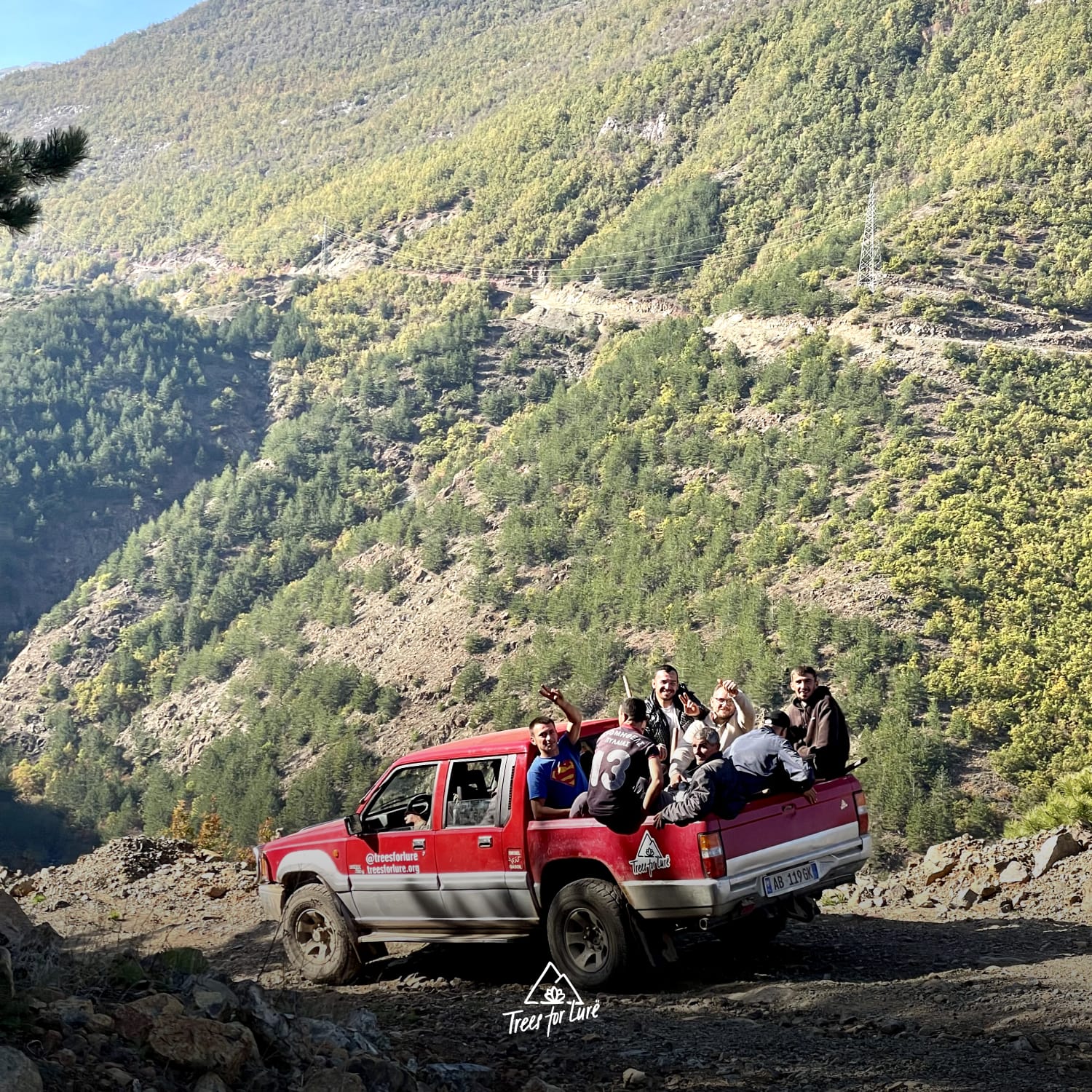
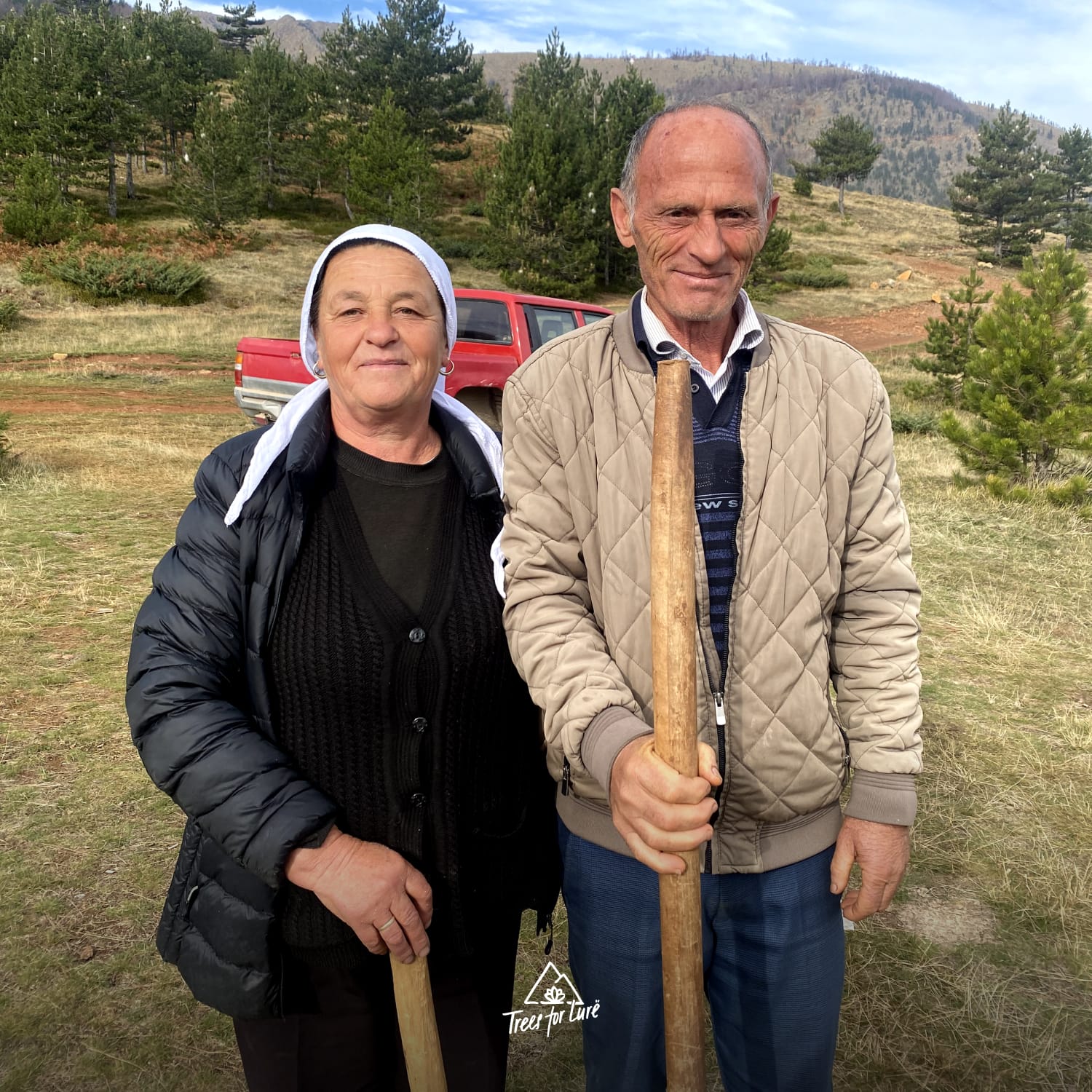
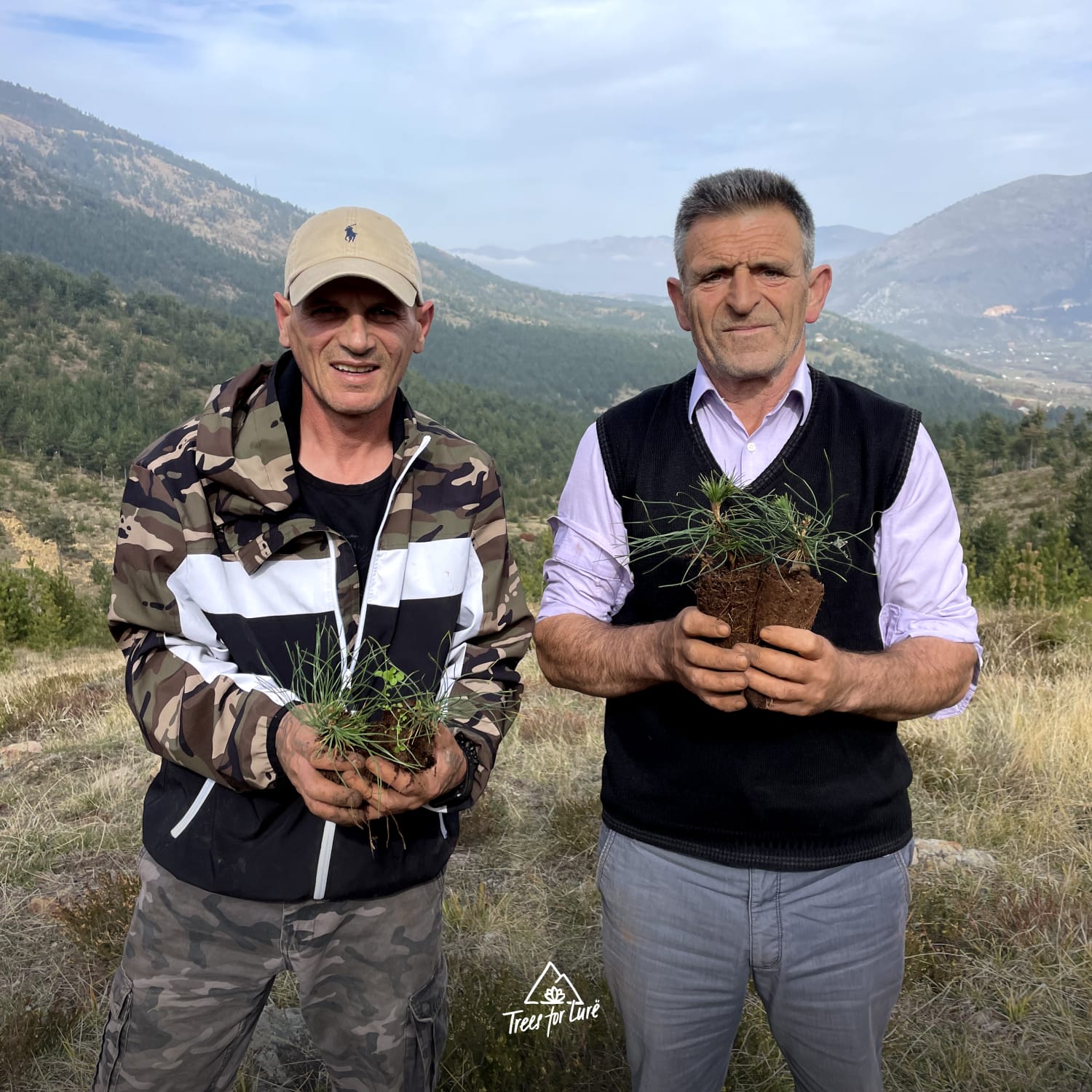
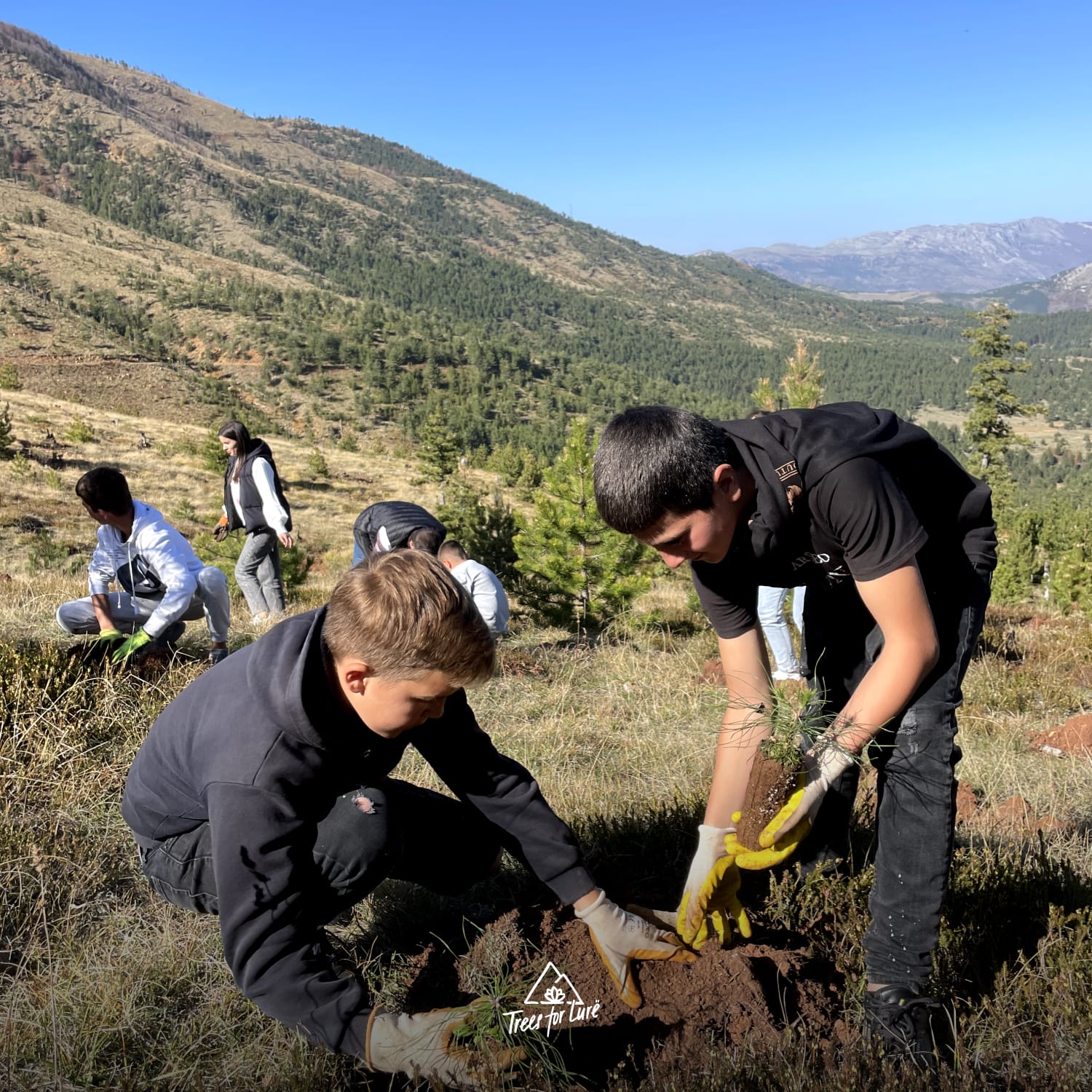
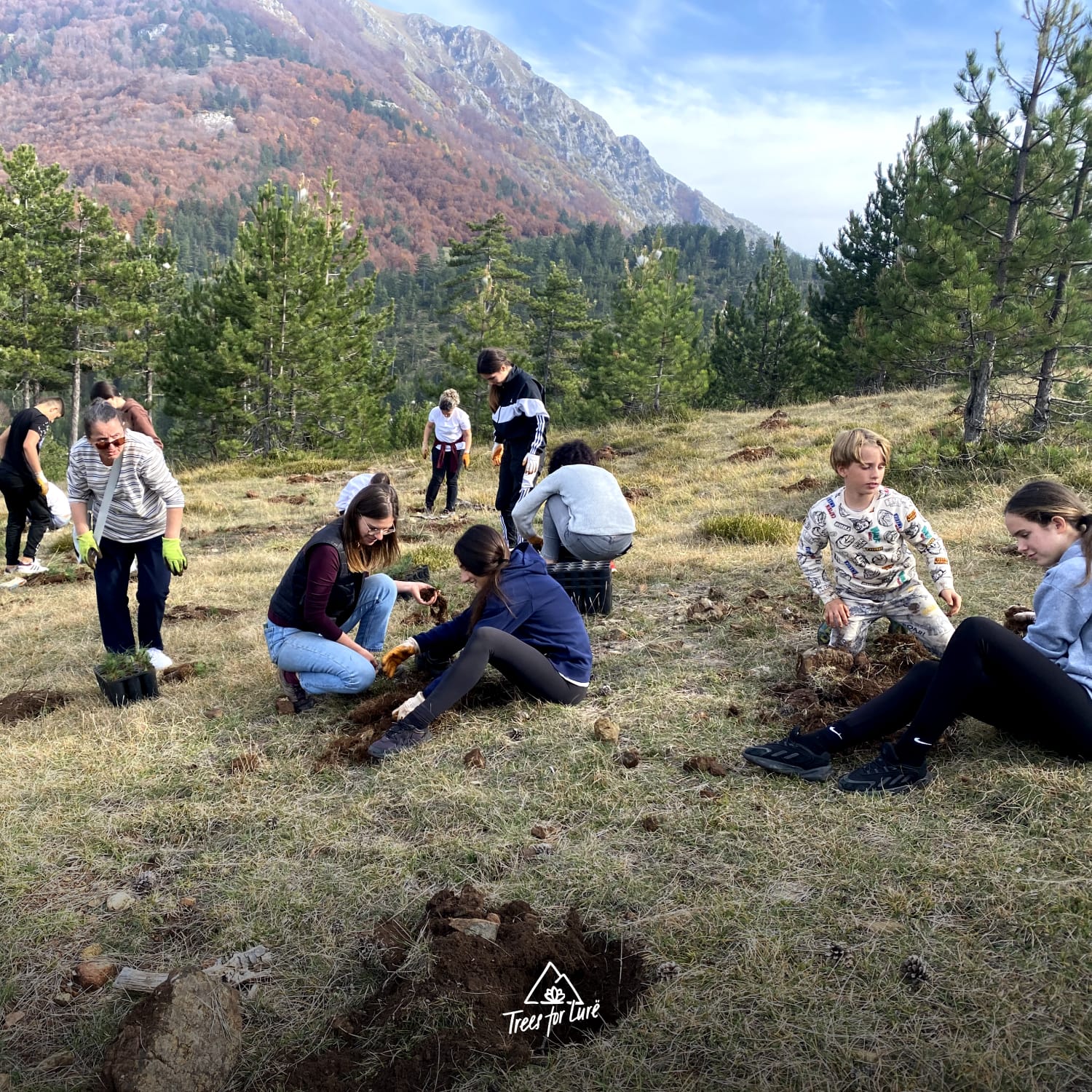
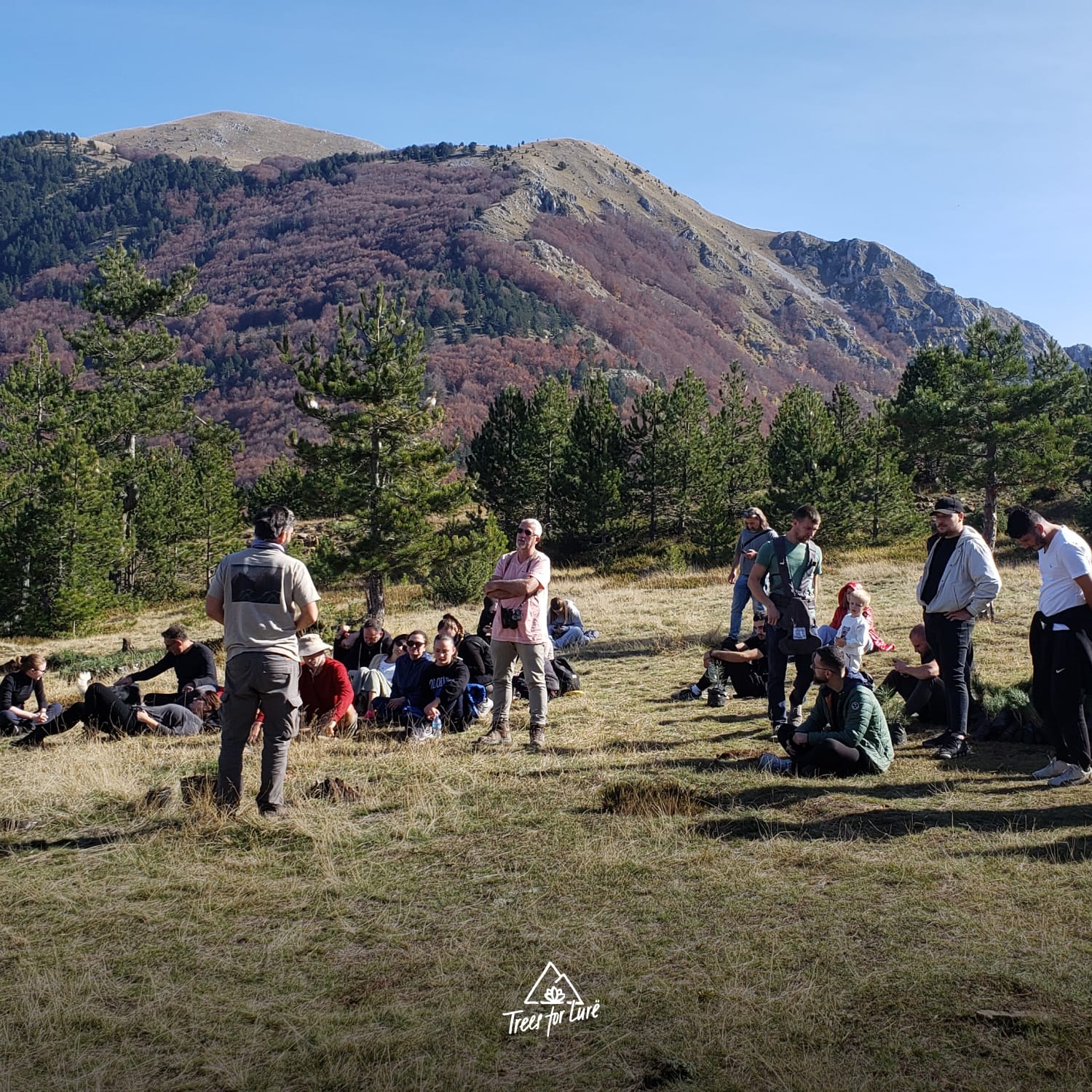
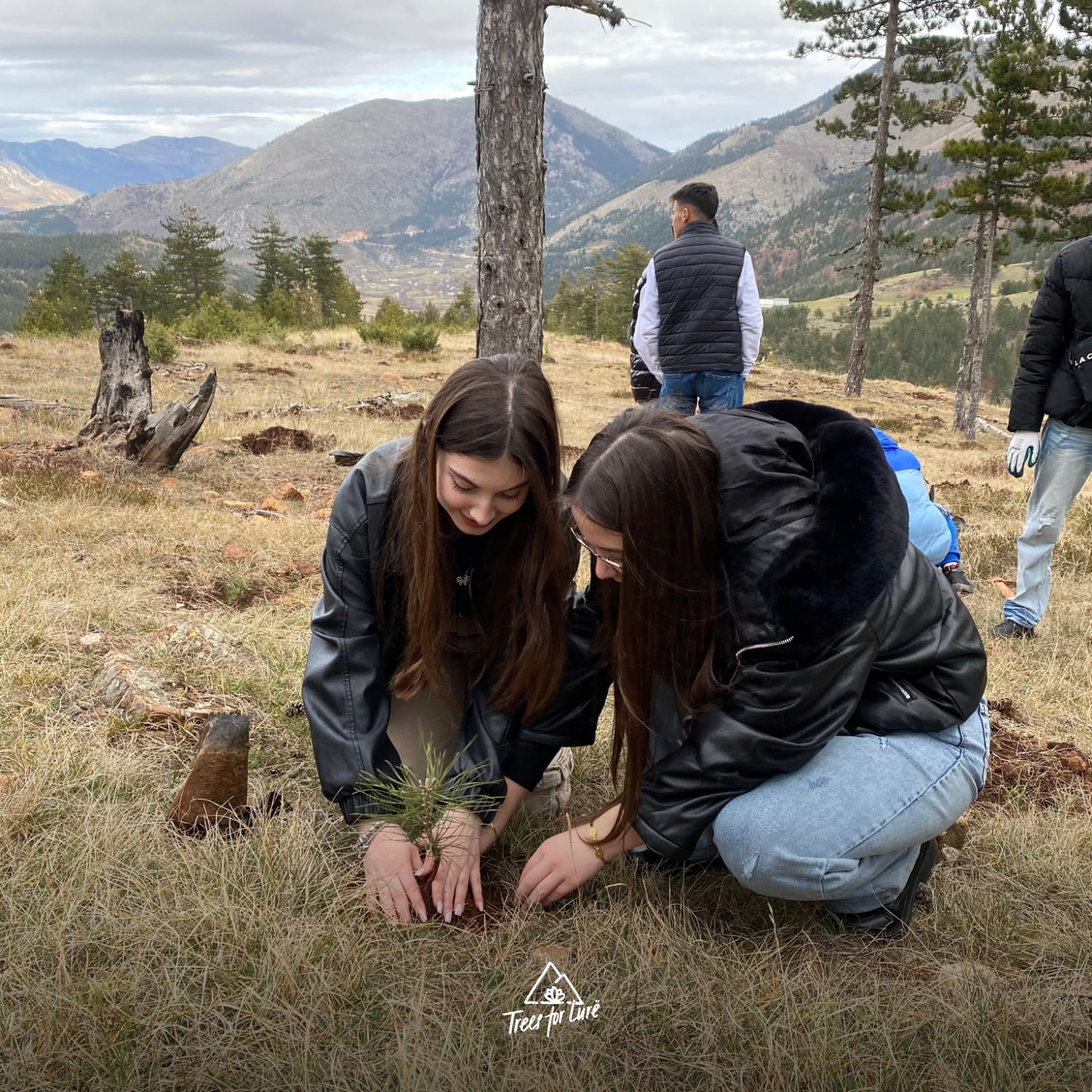
2023
10,081 / 6.38haFor 2023, we set high goals for ourselves: another 10,000 trees to plant and expand our tree nursery. It was not easy, but thanks to our team’s dedication, supporters and new partners, we achieved all our goals and more.
The year began not with reforestation but with the expansion of our tree nursery in the early spring of 2023. The nursery is crucial for the sustainable production of saplings locally in Fushë-Lurë, providing trees grown from local seeds and adapted to the local climate.
We have been working with the AKZM and AdZM Dibër on the 2023 planting proposal (location, tree species, methods). During summer, we obtained permission for our planting operation.
10,081 trees planted
The planting area for 2023 is close to the previous planting areas. It also suffered damage due to a forest fire in the past. The area is significantly steeper than the last areas and features a stream (with rocky slopes) passing from top to bottom. The total area of the allocated zone is 14.72 ha. However, due to existing vegetation and terrain constraints, only around 9 ha is available for reforestation, out of which we managed to plant 10,000 trees in the area of 6.38ha.
We executed the planting operation in two phases, and this year, we managed to plant 10,081 trees within two weeks instead of the four weeks it took in 2022. We prepared the area by digging holes during the first week, and the team planted trees in the second week.
Unpredictable weather (rain, snow) caused the planting operation to be delayed by a week and put time constraints on the team as the temperatures dropped quickly.
Of 10,081 trees, 1,081 came from our nursery, and we purchased the remaining 9,000 trees from Fidanishte Xhepi Sh.p.k. in Fushë-Krujë.
We planted the first trees from our nursery
This year was special for us as we planted the first 1,081 trees from our tree nursery, a huge milestone for the project.
The saplings planted this year were grown from seeds collected in 2021 and planted in the nursery in the Spring of 2022. Saplings from the nursery are smaller than commercially available ones but have a massive advantage in acclimatization to the local climate.
We planted these trees in a separate planting area, allowing us to monitor and evaluate the survival and growth rates easily.
Record number of local workers
We were pleased with ever increasing interest from the local community to work with us.
During our first planting operation in 2021, we had 6 workers, and 35 joined us this year. This huge increase has various reasons. However, the main one is that the project has gained the local community’s trust by operating consistently and transparently for the 3rd year.
During our planting operation, we provide equal opportunity for seasonal work to men, women and youth. At the end of each planting day, we pay salaries based on the amount of work done by each worker.
After three years of working with the local community, we have a well-trained, stable team of workers who work with us yearly (which also grows annually), with additional people joining us based on availability. This primary factor allows us to finish the planting operation within two weeks.
Bringing schools and students
This year, we introduced a new way to involve schools with kids from the village of Lurë and around Albania. The main scope was to have educational activities during the planting season as an additional program to the project.
We had an opportunity to show the kids the whole process, from the seeds - to saplings in the nursery - to planting trees in the National Park. We managed to have three separate events with three different schools. Read more, in Update #17.
The interest from schools was higher, but due to the rainy weather during the first days of November, we had to put many on the waiting list.
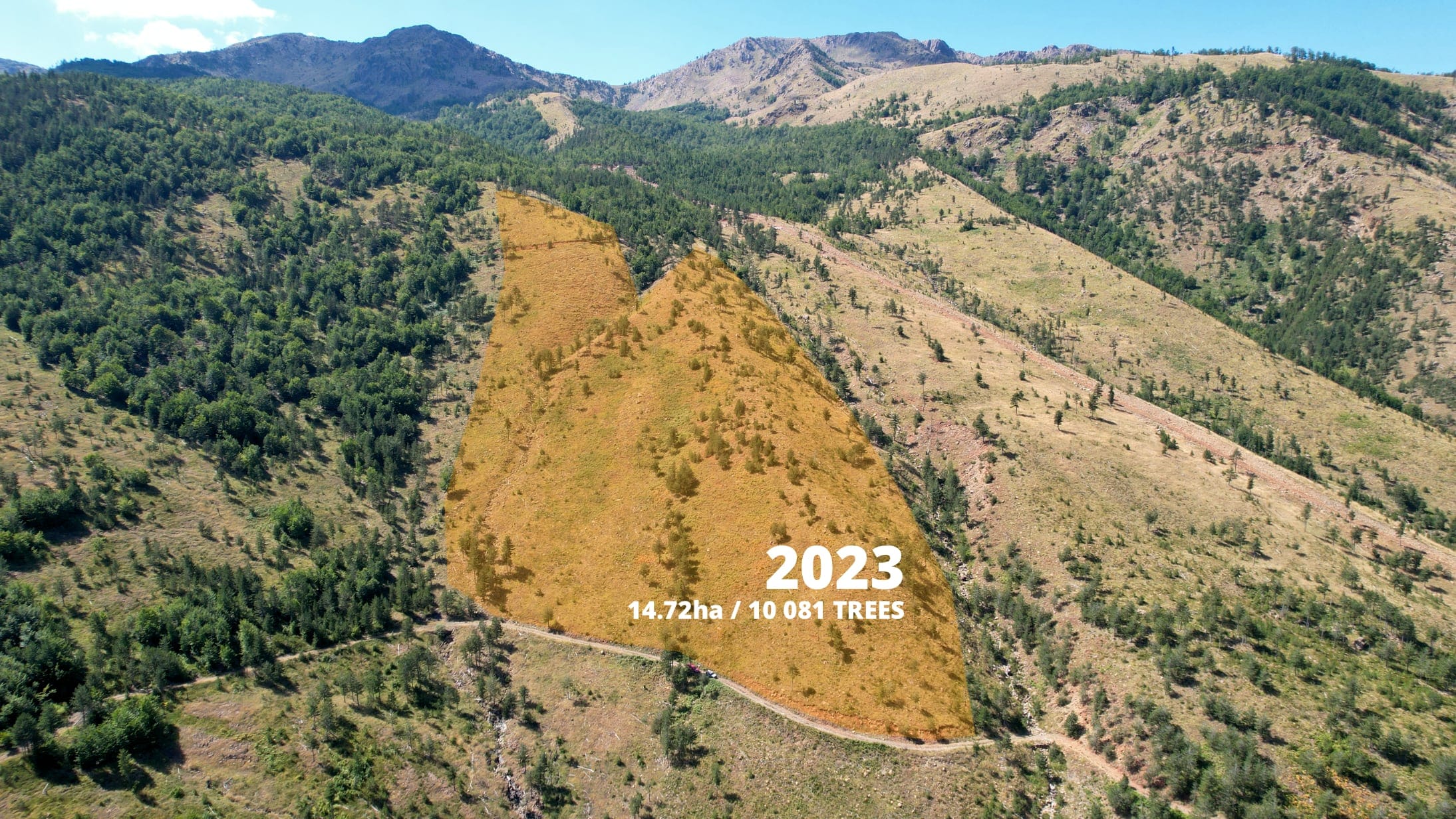
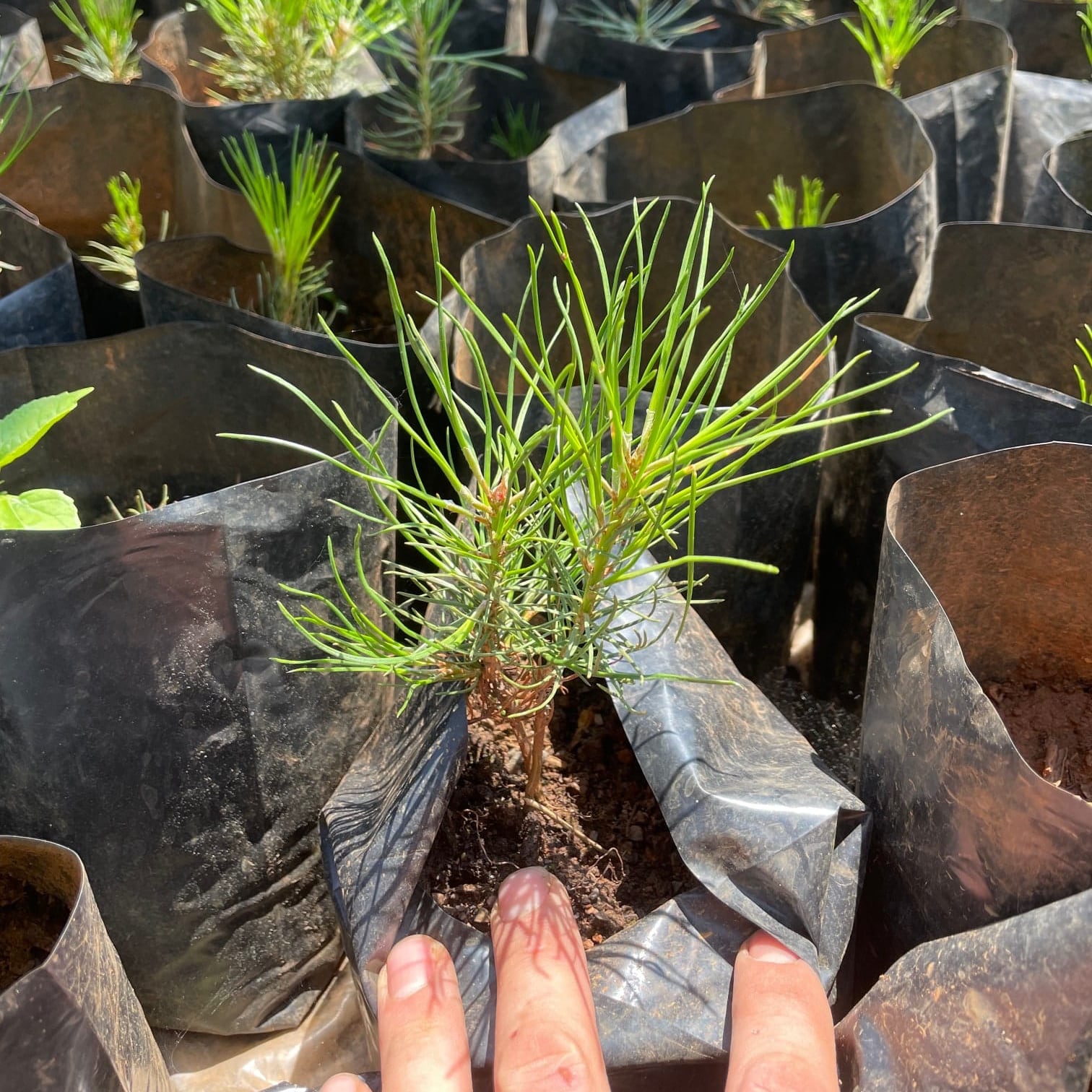
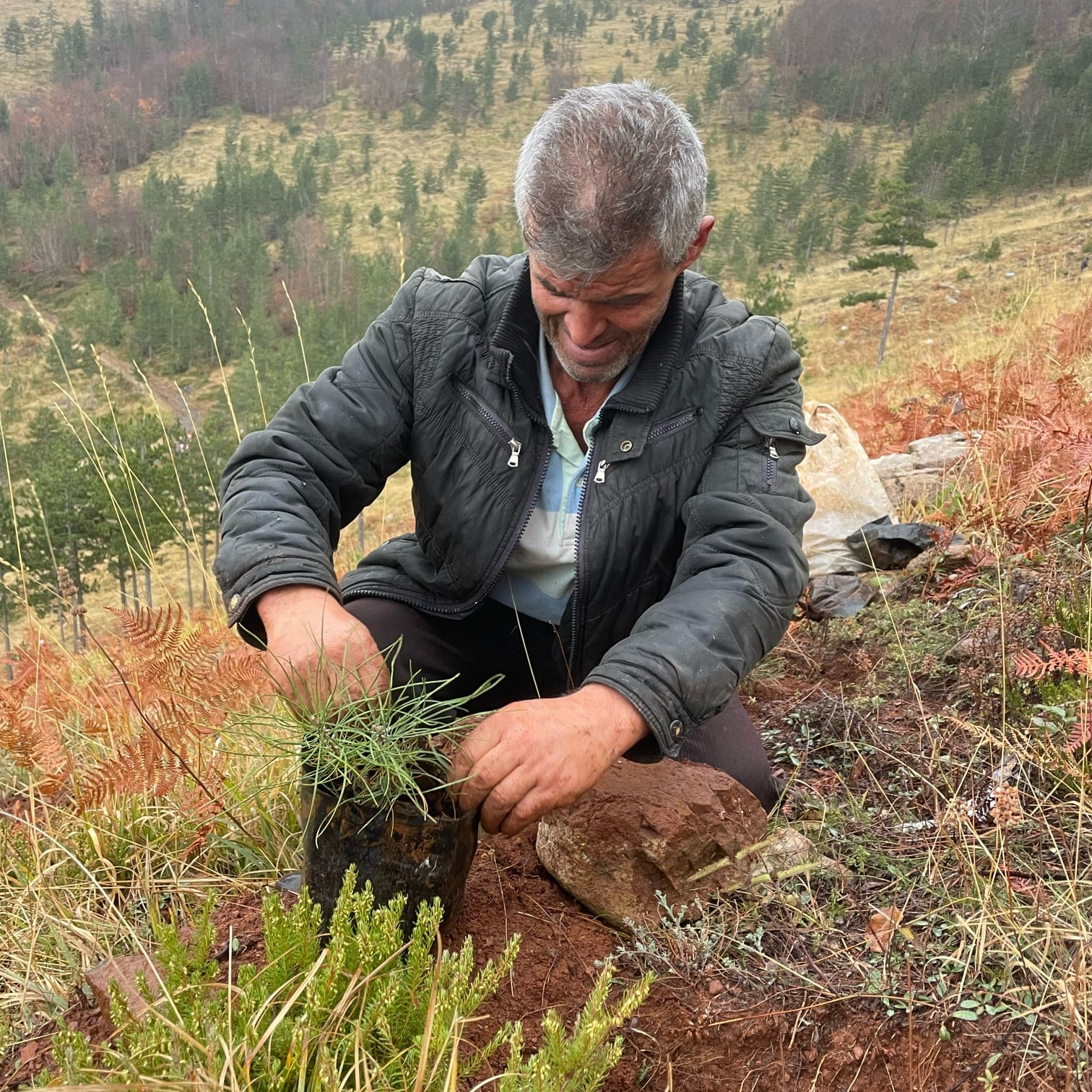
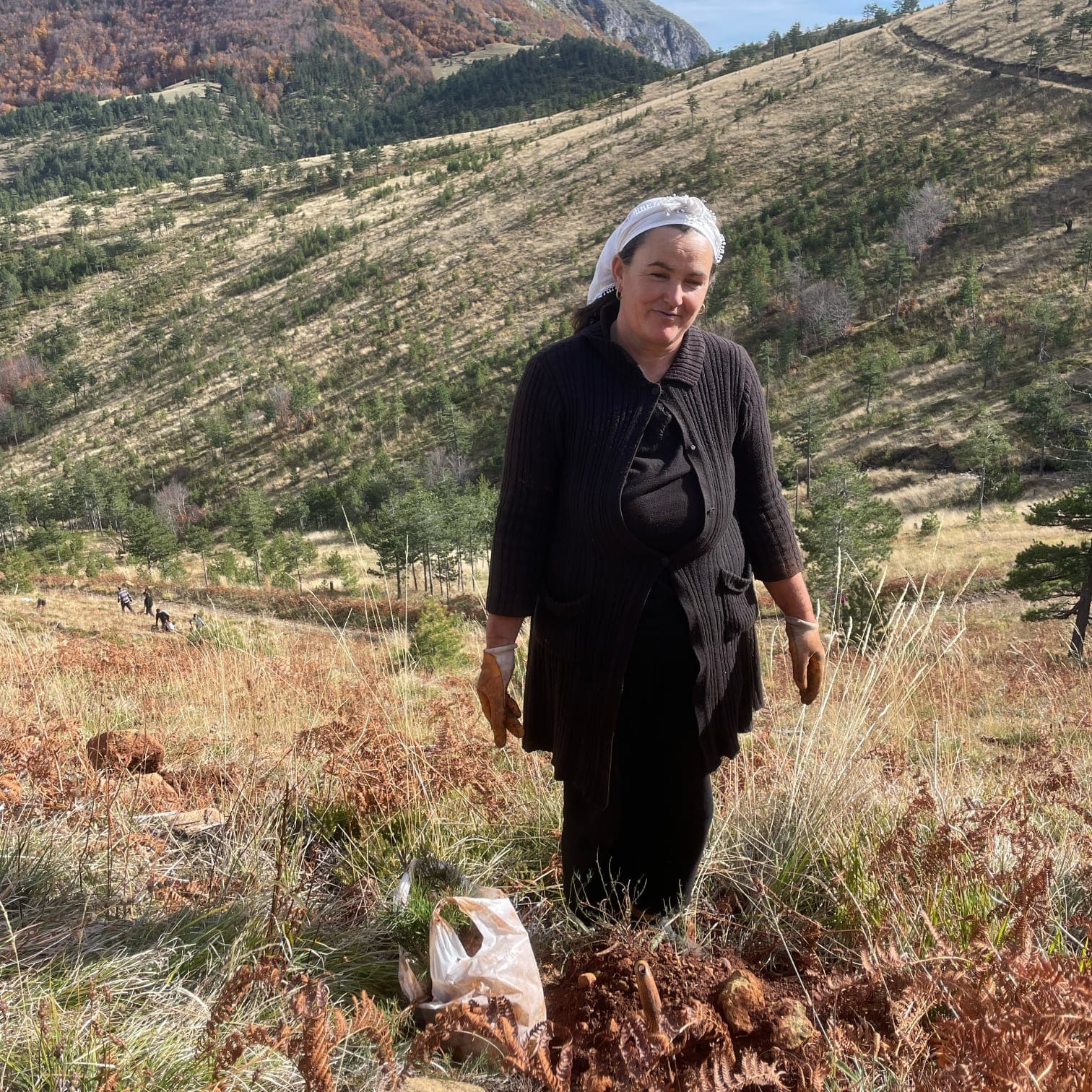

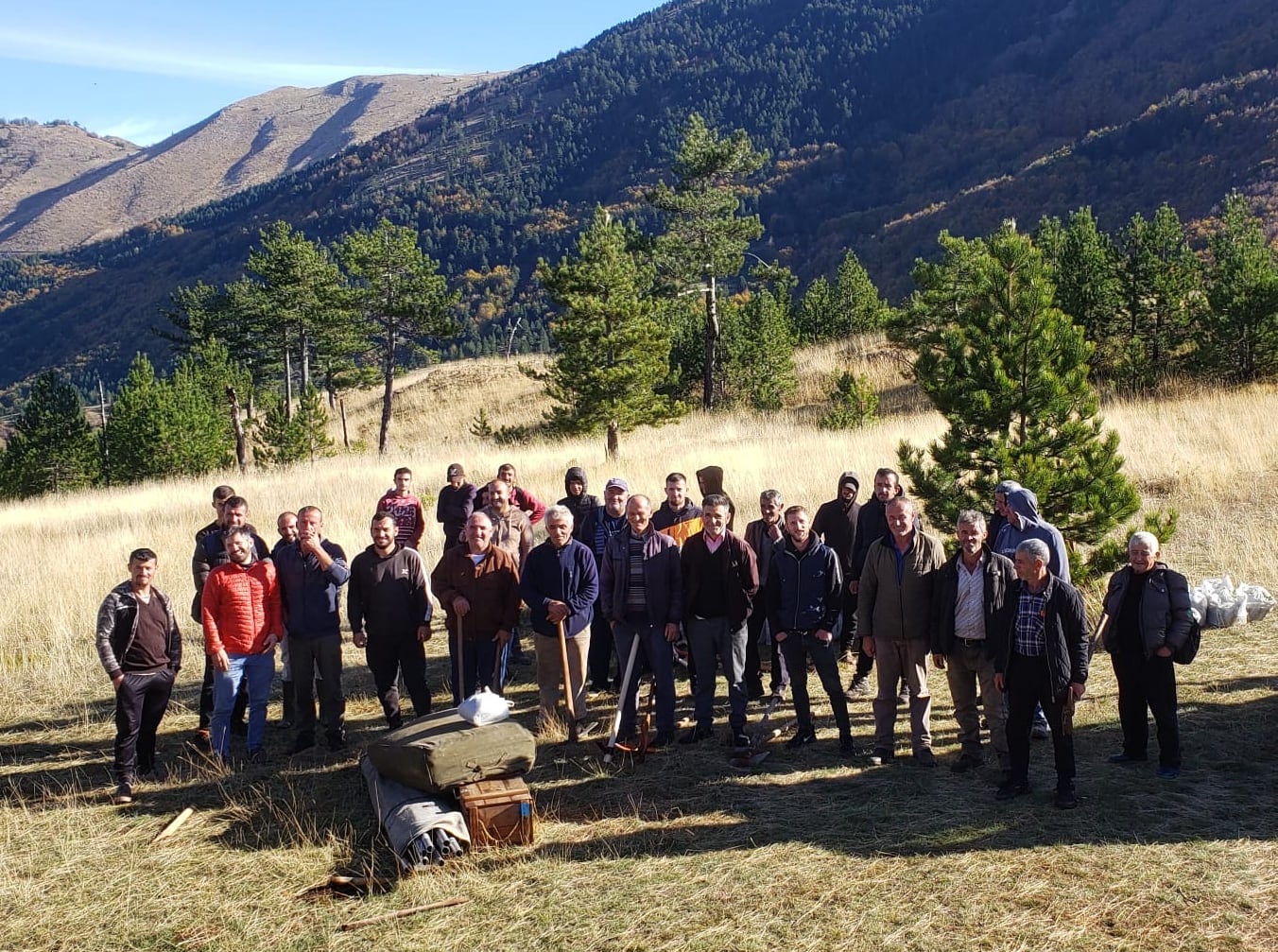
2022
10,000 / 6.64haSuccessful planting operation in 2021 and positive public feedback led to securing enough donations to challenge ourselves and plant 10,000 trees. We also established a Tree nursery pilot project to grow our saplings.
Thanks to starting smaller in 2021, with only 2712 trees, we gained the necessary experience to execute more extensive planting operations. The logistics of sourcing and transporting planting material, management of digging, planting and cash flow planning must be executed well to deliver a successful planting operation.
We received positive public feedback through social media or our TV appearances in Albania, which led to new relationships with corporate donors (risr/ and Heldenwerbung GmbH) in early 2022. Our presence in Lurë connected us directly with the motorcycling community which regards Lurë as a prime spot for off-road riding due to the famous international Trans Euro Trail leading them through the Lurë National Park. By May 2022, we secured funding for a much larger number of trees than in 2021.
Based on the above, we decided to take up a challenge and set our 2022 goal to plant an ambitious 10 000 Pinus nigra saplings and use the remaining funds to start the Tree nursery pilot project.
The tree nursery pilot project was an incredibly important task to execute in 2022. The tree nursery is crucial not only because producing our saplings will significantly lower the reforestation cost by cutting transportation and sapling purchase costs. It will also produce saplings which fulfil the requirements of the AKZM for planting material allowed for the highest protected areas of the national park. There is currently no supplier in Albania which can provide such saplings and our tree nursery is the first one.
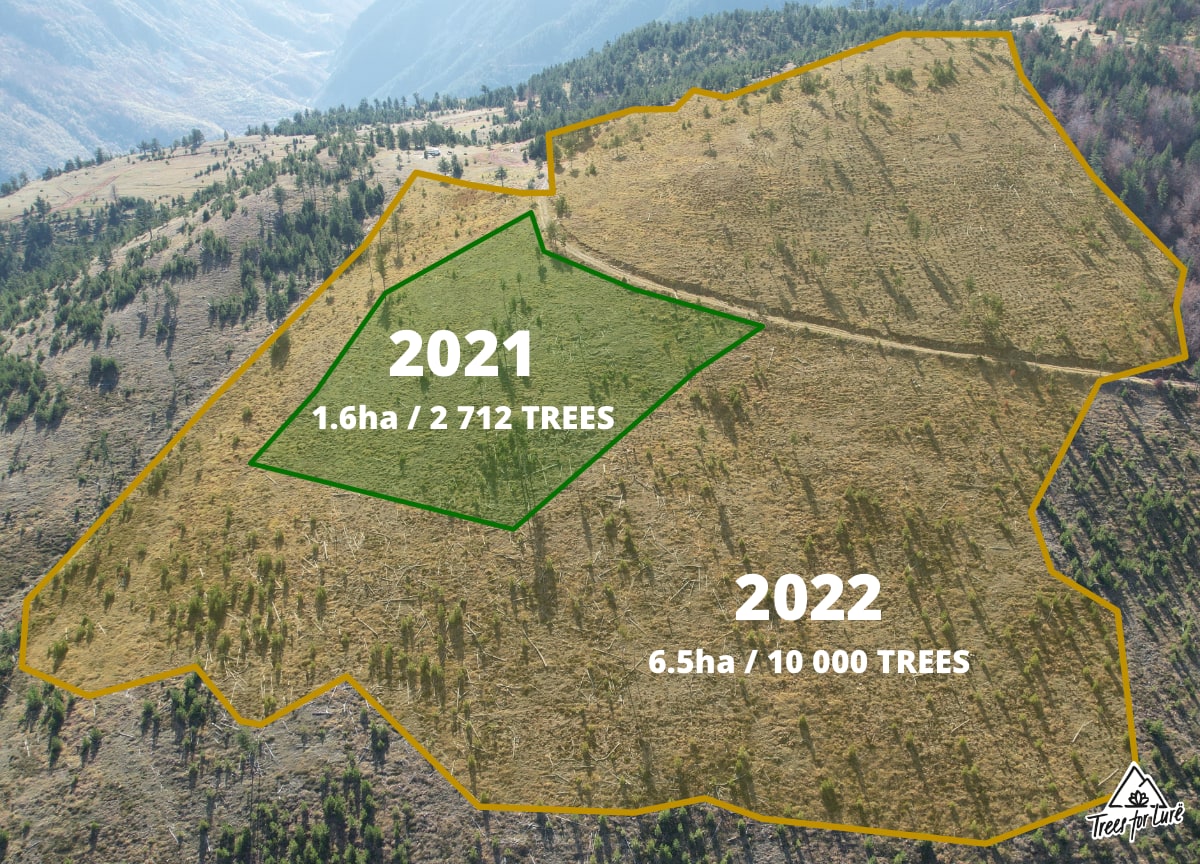
2021
2,712 / 2.2haWe have been active in Lurë since 2019, but unfortunately, due to the 2019 earthquake and COVID-19 pandemic in 2020, our first planting operation took place in 2021 when we planted 2712 Pinus nigra saplings.
Our original plan for 2021 was to plant 5000 trees in two planting operations. The first half is in early Spring, and the second is in Autumn. The correct Spring season to plant Pinus nigra is around March and April, and for the Autumn, it is October and November.
The Spring planting
The Spring planting operation failed as we could not reach the planting area due to the snow blocking the access road. Lurë National Park is located at an altitude of 1300—1800 a.s.m.l, and the snow melts around the beginning of June, an important lesson to learn.
The season for planting Pinus nigra is in March and April, but the main areas suitable for reforestation are not accessible till the beginning of June. This makes planting in Spring tricky, especially in combination with unpredictable weather when snowfall and very low temperatures are common till the end of May.
All these difficulties with the Spring season lead us to the decision that it is better to skip the Spring planting season and focus on Autumn. The risk of bad weather and logistical challenges are just too high.
The Autumn planting
During the year we had enough time to prepare everything for the Autumn planting operation in. We did detailed research of the suppliers for the Pinus nigra saplings and personally visited all suppliers to check the quality of their saplings. We chose Xhepi Sh.p.k (Fushë-Krujë) & Lurimi Sh.p.k (Burrel) to supply our saplings with 50/50 split to evaluate the performance of the saplings during next 3 years. We had enough time to prepare everything for the Autumn planting operation during the year. We did detailed research of the suppliers for the Pinus nigra saplings and personally visited all suppliers to check the quality of their saplings. We chose Xhepi Sh.p.k (Fushë-Krujë) & Lurimi Sh.p.k (Burrel) to supply our saplings with a 50/50 split to evaluate the performance of the saplings during the next 3 years.
The 2021 Autumn planting was a huge milestone for the project and a wonderful 2-day event that brought together the whole team and many volunteers to plant the first 2712 trees.
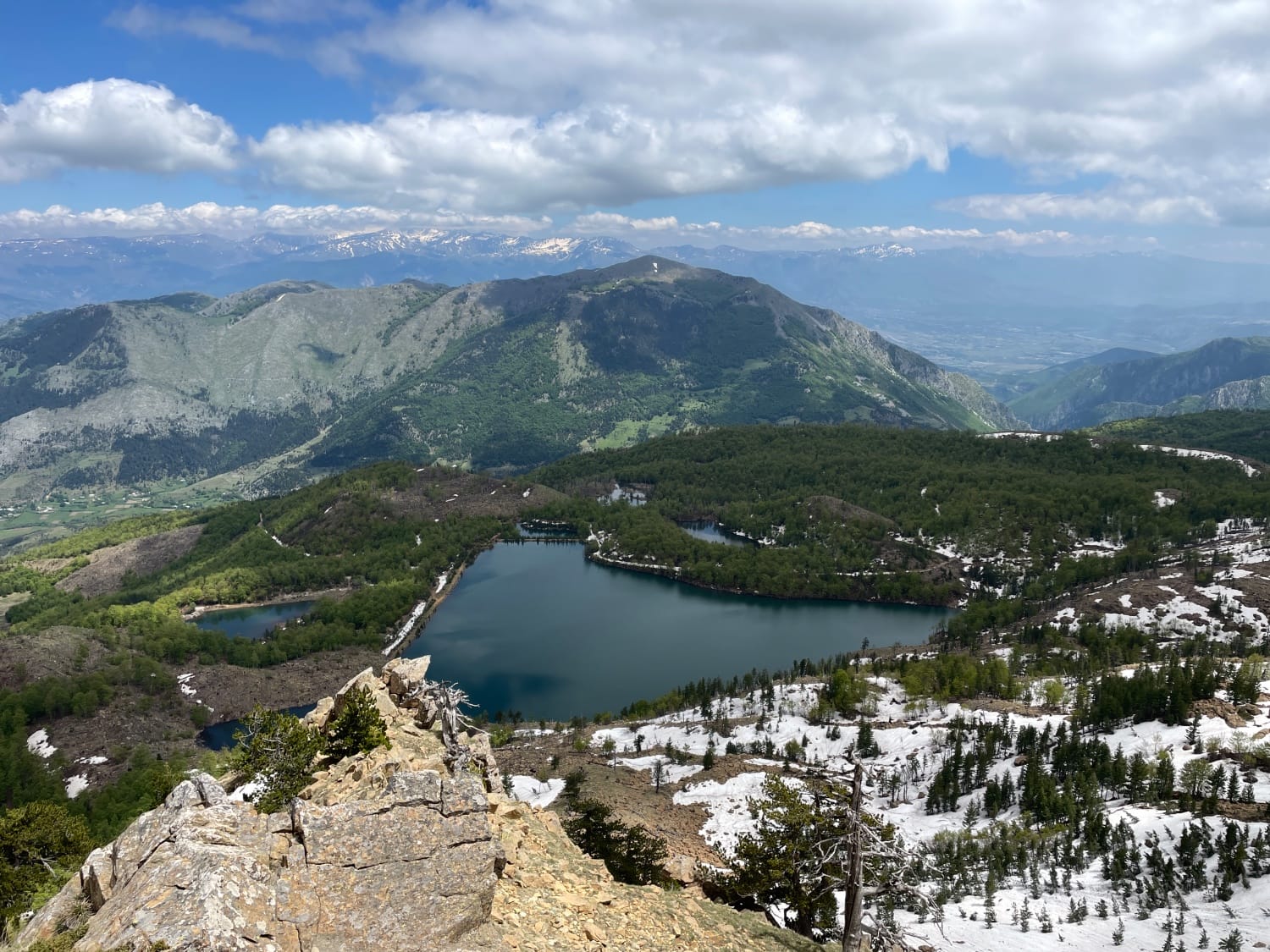
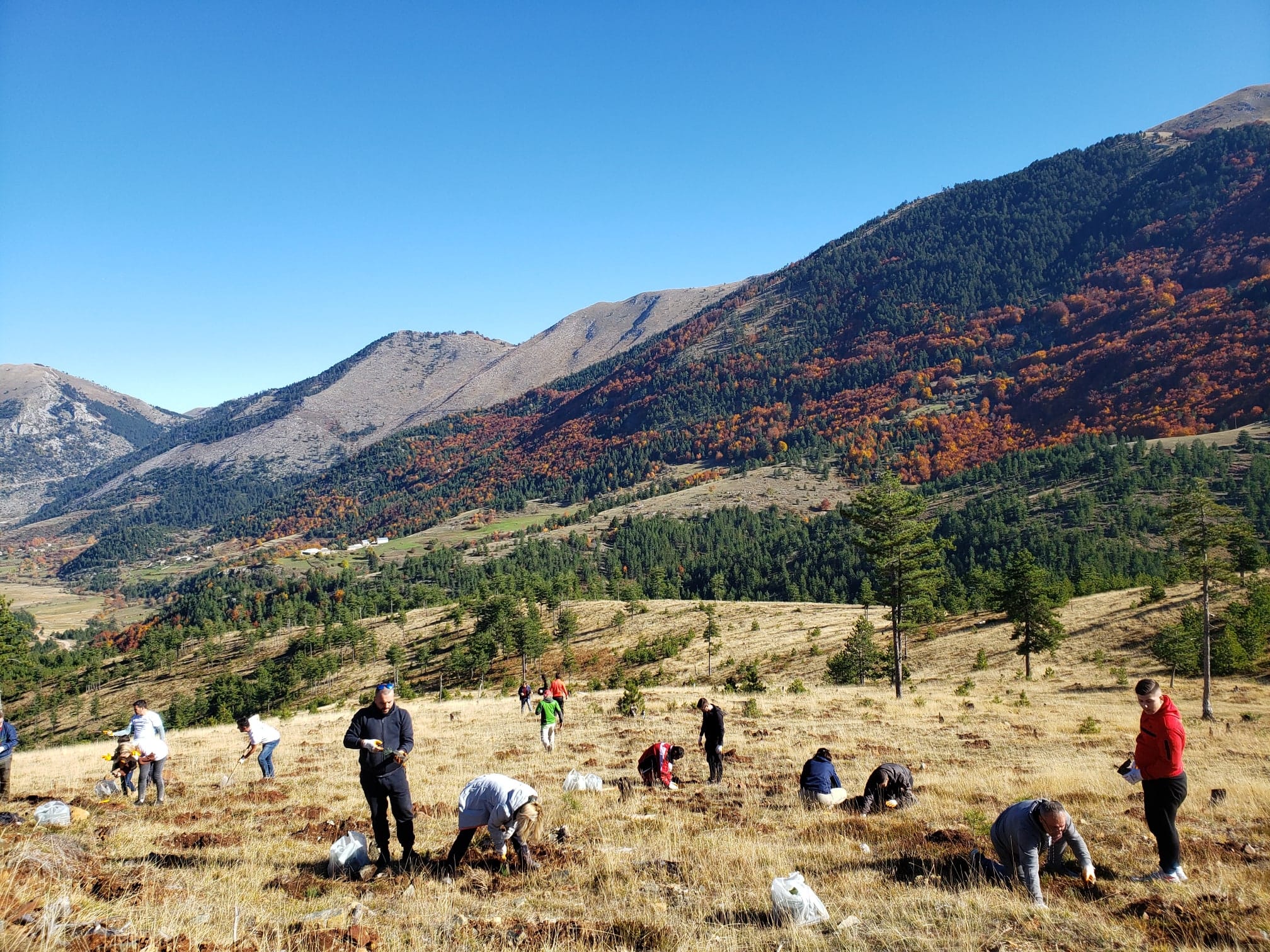
Lurë-Dejës Mt. National Park
Lurë-Dejës Mt. National Park is one of the most beautiful and wild national parks in northeastern Albania, which protects an area of 202.42 km2. The altitude varies from 1,300—2,300 a.m.s.l. The most common native tree species to Lurë are European beech, Silver fir, Black pine, Red pine and Macedonian/Balkan pine. Especially protected is the Macedonian/Balkan pine, which is threatened with extinction and is only common in the west of the Balkan Peninsula.
Unfortunately, it suffered massive deforestation due to illegal logging and a series of forest fires which decimated its forests. These actions left up to 500ha completely deforested; most of this damage is in the highest protected areas of the national park, around the Lurë lakes. It is estimated that reforestation of the damaged areas would require planting around 1 200 000 trees.
Which tree species we plant?
Lurë-Dejës Mt. National Park is a protected area under the management of Agjencia Kombëtare e Zonave të Mbrojtura (AKZM). The AKZM sets requirements for the planting material allowed to be used during planting operations within the national park.
Conifer species allowed to be planted in the national park are Pinus nigra, Pinus Peuce and Abies alba, and as for deciduous species, it is Fagus silvatica.
Furthermore, there are requirements based on the planting area regarding its location within three protected zones. Our goal is to plant in the highest protected zone where the saplings must be produced from the local seeds and grown at a similar altitude as the planting area. Such saplings are currently not produced in Albania or within the Balkan peninsula. This is why we established a tree nursery in the Lurë area.
Our planting areas are currently located within the 2nd protected zone of the national park, where we are allowed to plant Pinus nigra saplings from Albanian suppliers located in lower altitudes. We plant two-year-old, potted/containerized saplings.
In our experience, using old and larger saplings does not produce good results as those plants are prone to damage due to snowfall. You can read detailed information about our planting material selection process in Update #10: Choosing the right planting material and supplier.
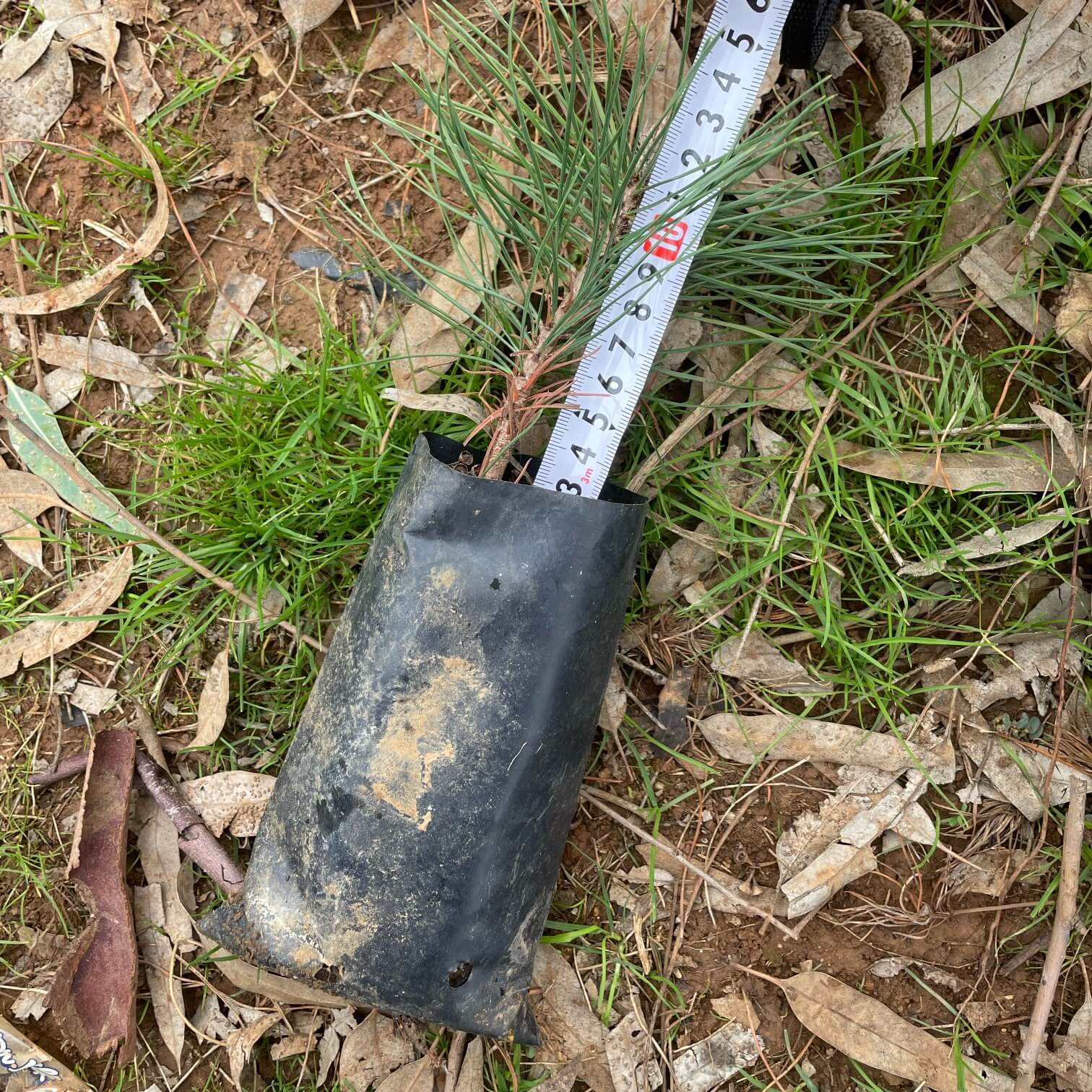
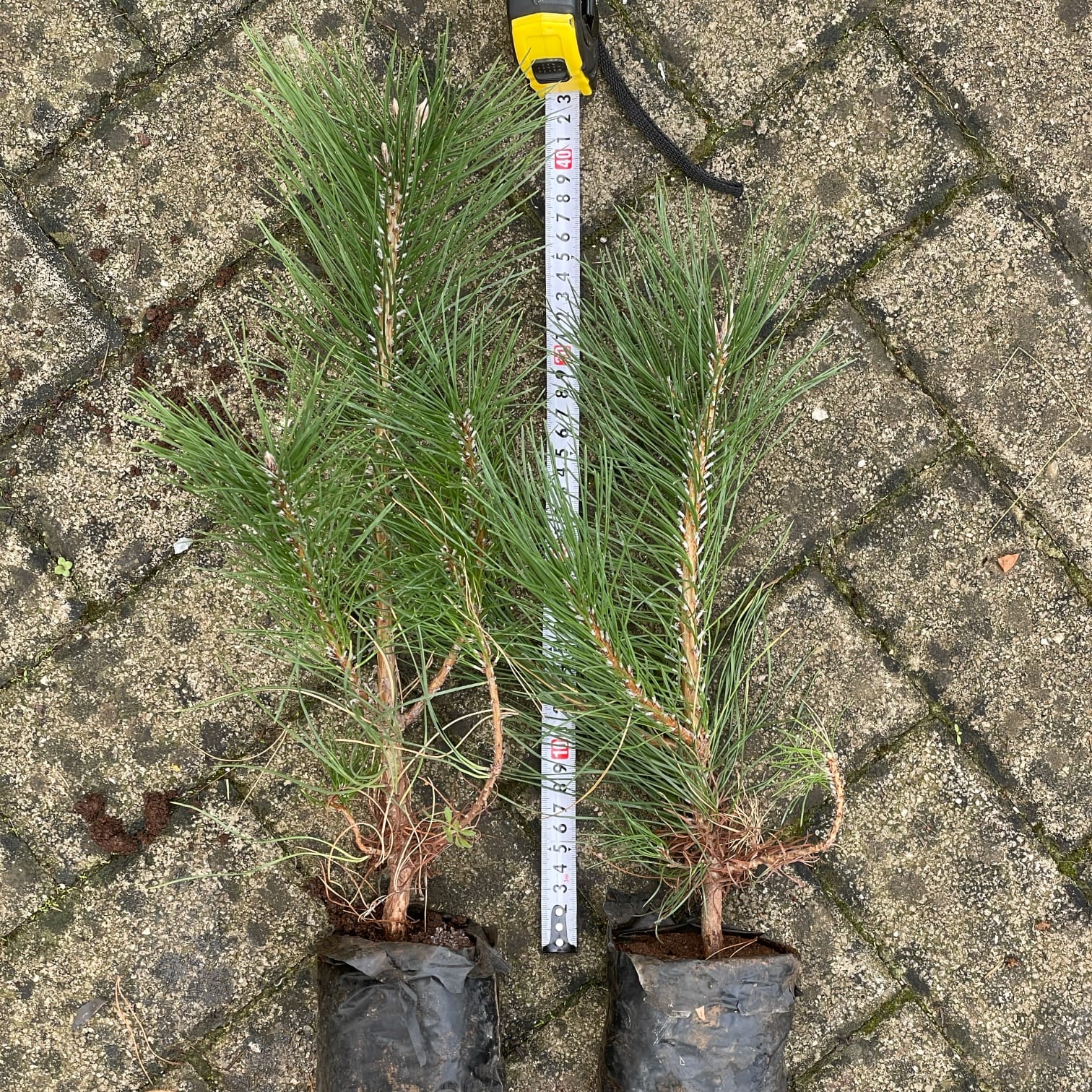
How do we plant?
Support and involvement of the local communities are crucial for successful and sustainable reforestation projects. We, therefore, award most of the work to the local team instead of volunteers.
Local workforce
We use the local workforce as much as possible during our reforestation activities. The local team plants 90% of the saplings. Our local team is responsible for a wide range of activities, from preparing the planting area, digging holes for the saplings, transportation and planting of the saplings.
This allows us to contribute significantly to the local economy, and more than 50% of the planting costs are dedicated to the workers. We provide much-needed jobs in the Fushë Lurë, which despite being seasonal jobs, are at least regular.
We are proud that our planting team includes many women because whole families are joining during our planting operations.
Volunteers
We organize weekend activities for volunteers and our partners to allow the public to participate in our reforestation project and demonstrate our processes and techniques. Due to its duration, we are limited to four events during the Autumn planting operation.
Limited use of volunteers ensures that the local team is allocated promised work and the planting quality is not compromised as the local team has more training and experience.
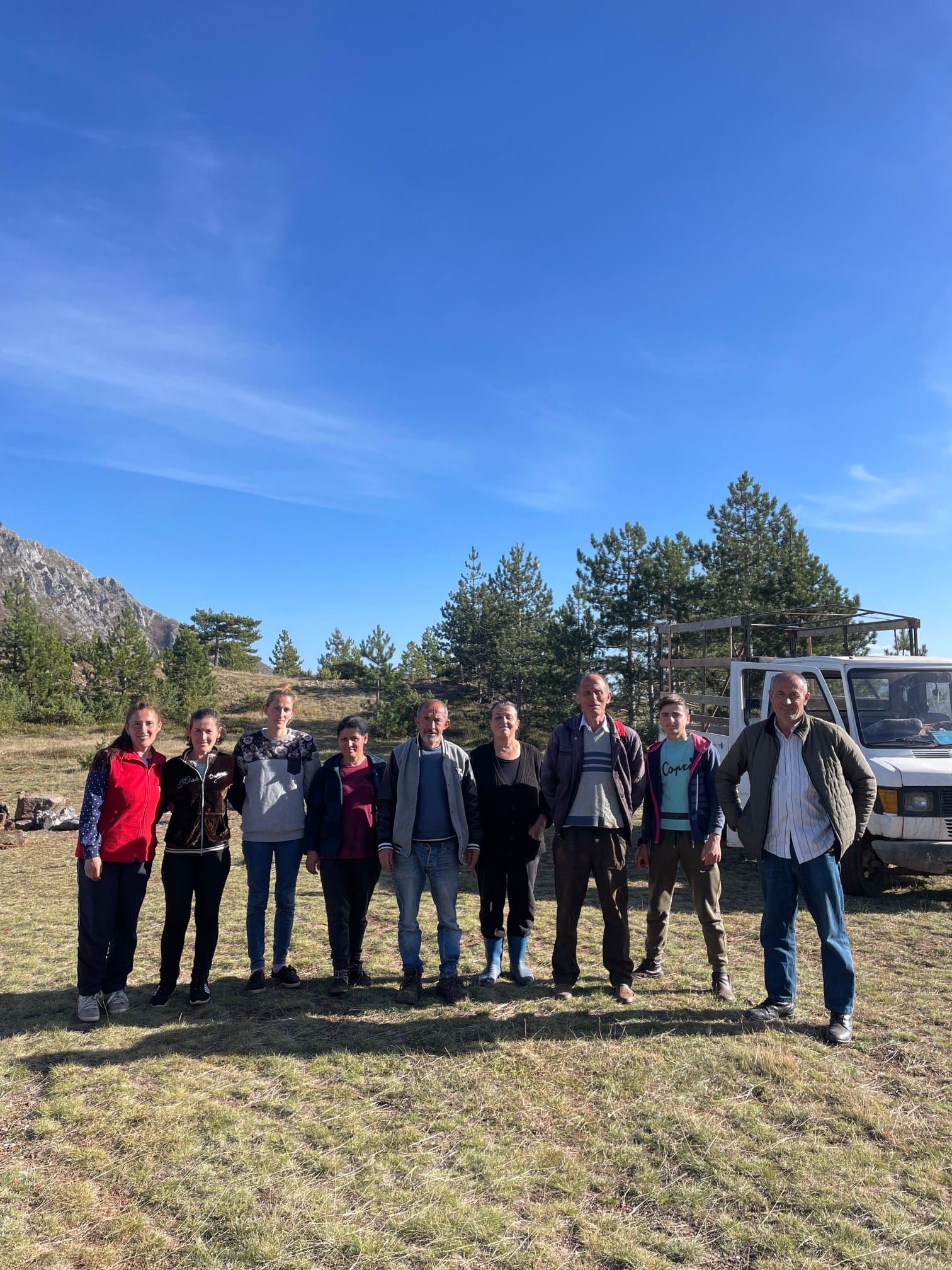
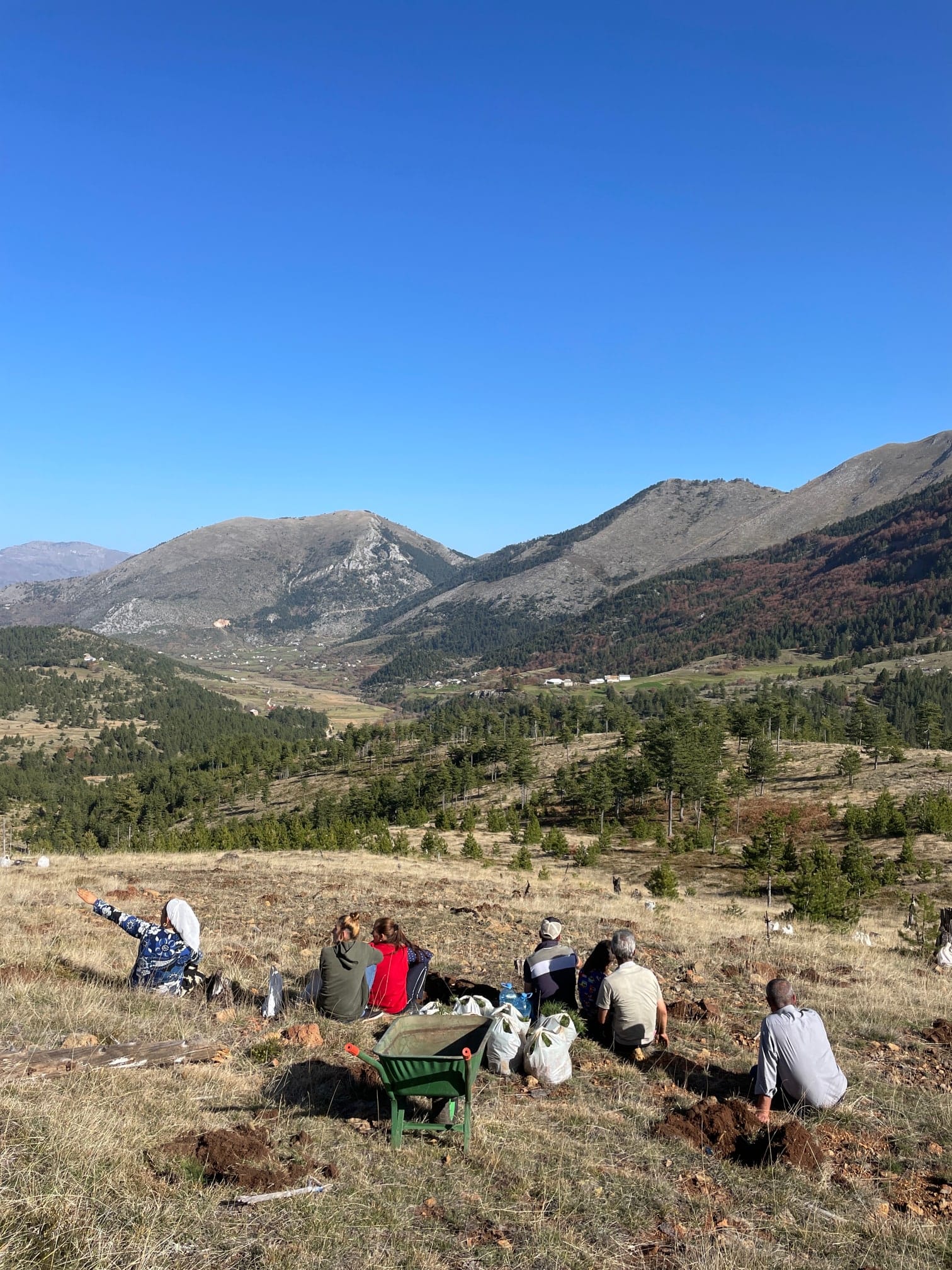
How are we monitoring?
We are using the Sample plot method to determine the survival rate for our reforestation operations. The method is based on establishing a number of sample plots (measuring areas) within the reforested area and measuring the survival rate within the plots. The final survival rate for the area is then an average of the sample plot values within given confidence intervals.
This method is widely used in reforestation projects and we were asked to adopt for our cooperation with OneTreePlanted. More details about the methodology can be found in very detailed PACTO: Monitoring protocol for reforestation projects manual.
We are using QGIS to capture our planting areas on the map and generate randomly distributed monitoring points for each area. The size of the area determines the number of plots, and we use the values in the table below as per the PACTO manual.
| Area (ha) = A | Number of Sample plots | Our areas and number of plots |
|---|---|---|
| A < 0.5 | 1 | 2023-B = 1, 2022-ADZM = 1 |
| 0.5 < A ≤ 1.0 | 5 | |
| A > 1 | 5 + (1 per additional hectare) | 2021 = 8, 2022 = 12, 2023-A = 12 |
In Albania, according to Manual për Pyllëzimet, 2023, section 8.6.2., the number of sample plots for projects under 30 ha should be at 3% of the area in 1st year and 2% for 2nd year. For example, our 6.38ha 2023-A area should have 19 and 12 plots respectively, however we monitor for 3 years using the same plots and therefore we chose to use 2% for all 3 years.
We establish the sample plots at their generated coordinates as roughly 100m2 squares marked with wooden sticks. Each square is then counted for the total number of trees and the number of dead trees, from which we can calculate the survival rate. During monitoring, we also note additional attributes such as terrain properties, water situation, other vegetation, and so on. The monitoring point is then used for three years of measurements.
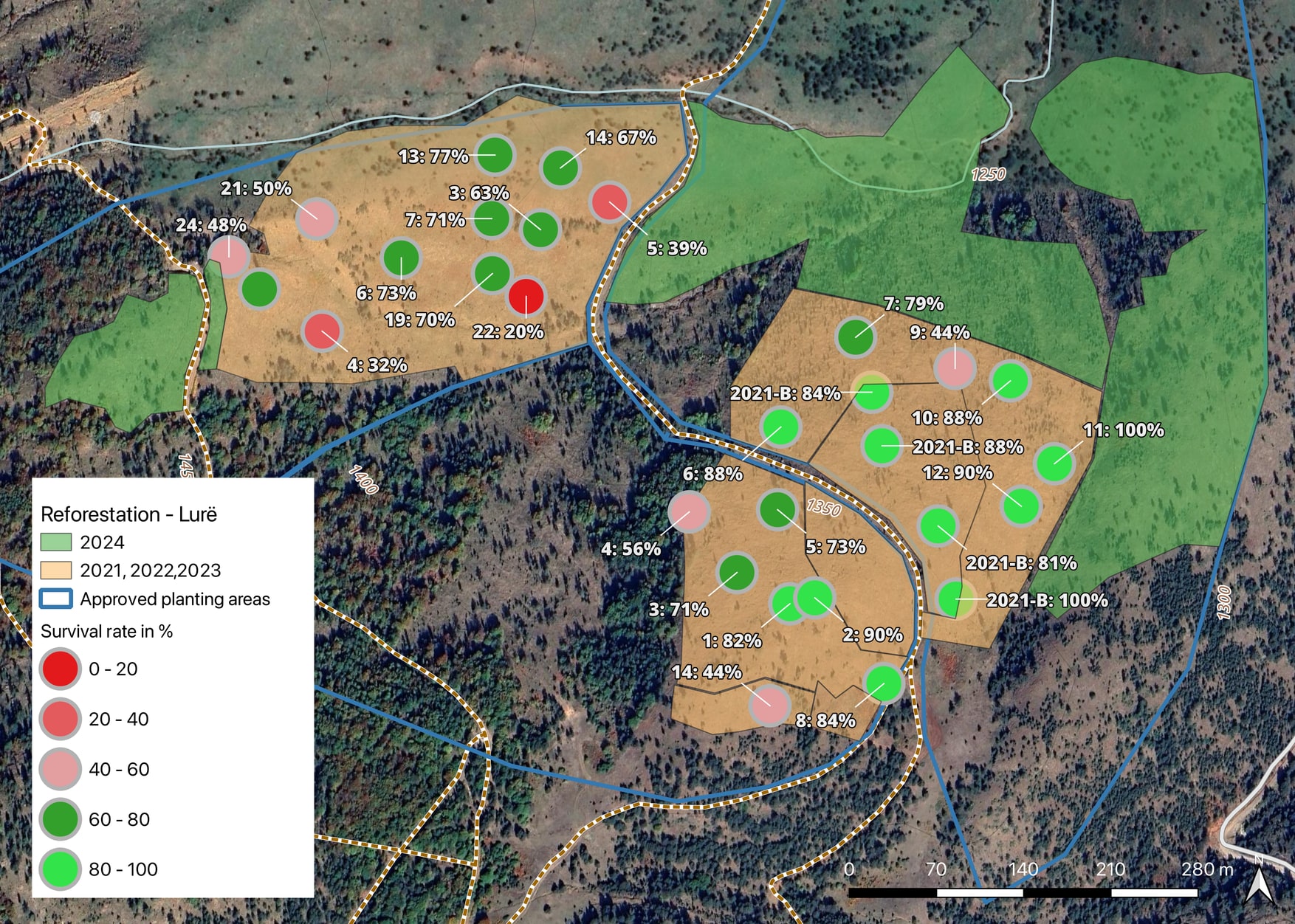

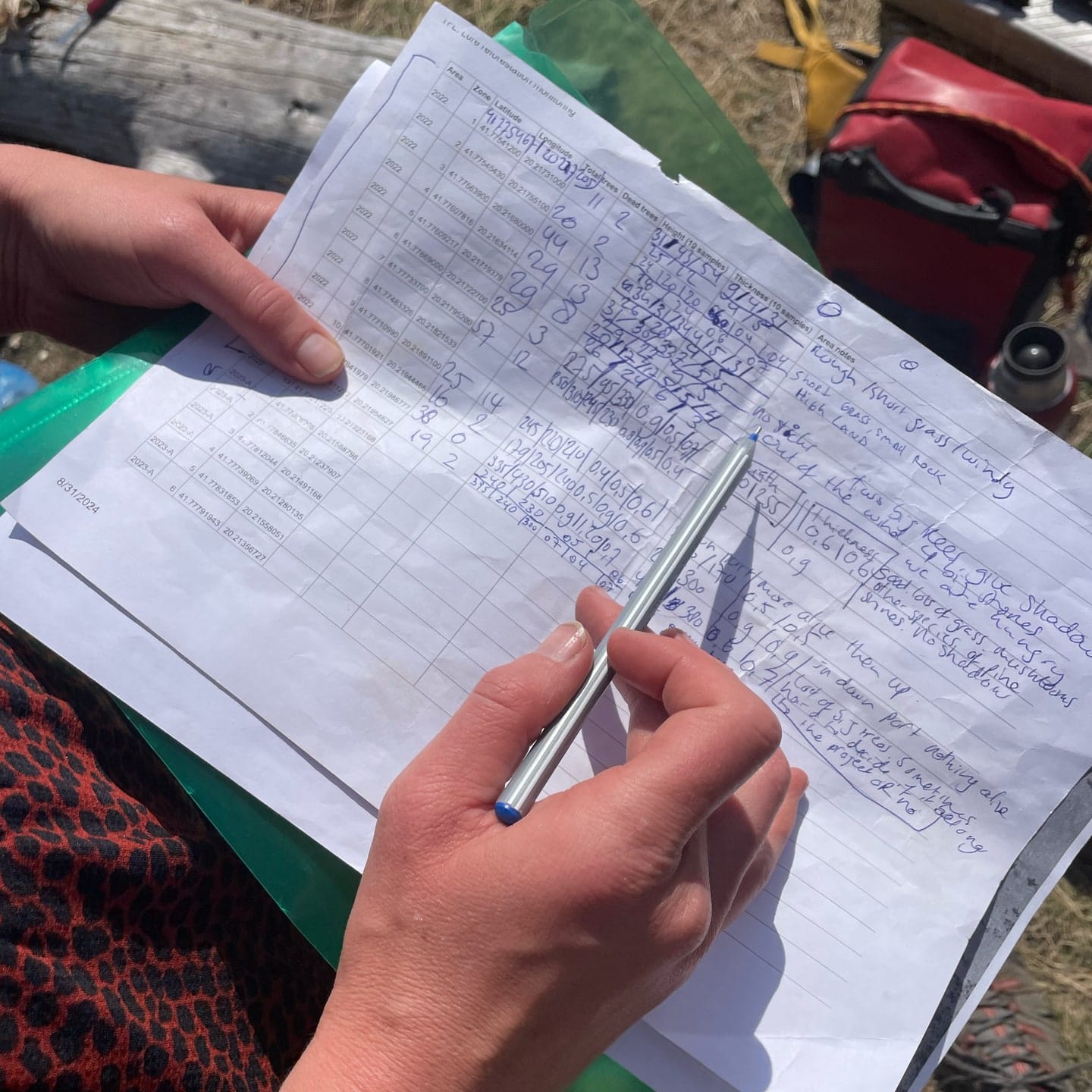
What are major risks?
Our planting areas are remote, which minimizes risks from human interventions and grazing cattle. Two significant risks to reforestation efforts are forest fires and Processionary.
Forest fires
Forest fires are a severe risk anywhere in the Balkan peninsula. In the past years, the has been an increased number of forest fires throughout the region, causing substantial damage. In Lurë majority of the fires are caused by human actions. Fighting the forest fire in Lurë is also complicated due to poor road infrastructure. Most of the national park is only accessible by 4x4 capable vehicles. The lack of government funding into fire fighting infrastructure does not improve the chances of adequate fire protection.
Processionaria
Processionary (Thaumetopoea pityocampa) is a widespread pest in the Balkan peninsula, Italy, Spain and many other southern countries. In the past, the pest was managed by the local workforce. Now, however, there is no coordinated strategy in place in Albania.
Processionary is a moth that lays eggs on the branches of pine trees. Once the eggs hatch, the larvae nest on the branches and start feeding on the needles. The larvae are covered with hairs poisonous to humans and animals, making managing the pest very difficult.
The pest affects mainly Pinus nigra forests up to an altitude of around 1500 a.s.m.l. Our current planting areas are at the altitude of 1300 a.s.m.l. which makes trees we plant suspectable to infestation in the future.
Processionary is absent in higher altitudes (highest protected areas) of the national park, which is why we want to focus our work there. Furthermore, Processionaria does not affect Abies alba and Pinus peuce is affected only minimally, which is yet another reason to work in higher altitudes where we are required to plant a combination of Pinus nigra, Pinus peuce and Abies alba, which we are producing in our nursery.


CARBON OFFSETTING
Forests play an important role in supporting the environment, habitats and protecting biodiversity. They also function as carbon sinks because forests are able to capture huge amounts of CO2.
Trees we plant will capture the carbon from the atmosphere for another 30 years before they get saturated with CO2. Based on the calculation from EcoTree a tree can absorb 10—40kg of CO2 in a year.
This number is significantly lower for the saplings we plant due to the size of the planted trees. We are using 0.025kg of CO2 per tree per year for our calculation at the beginning of the report. Therefore for 22,973 trees planted in 2021, 2022 and 2023 we estimate to offset 575kg of CO2 per year.